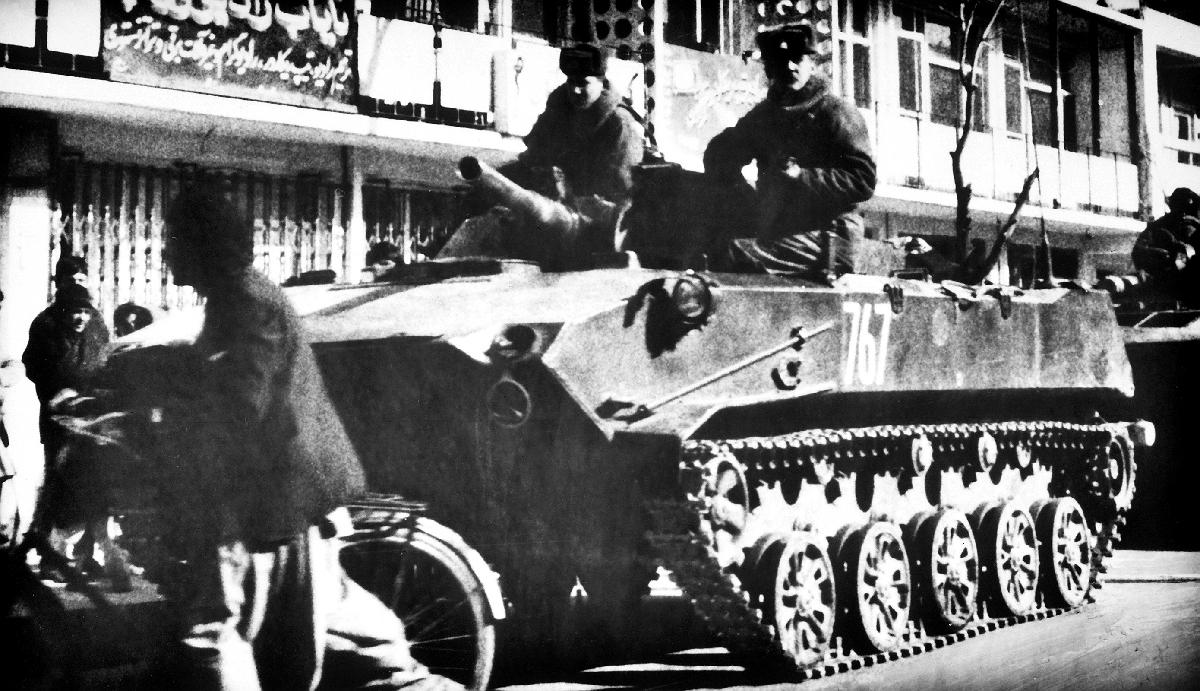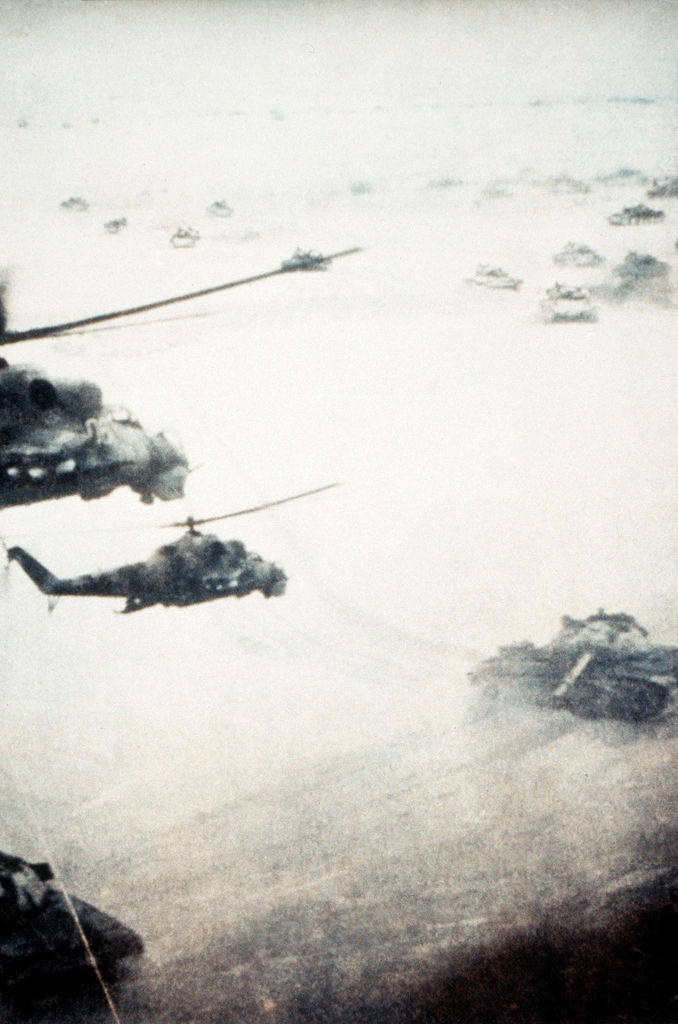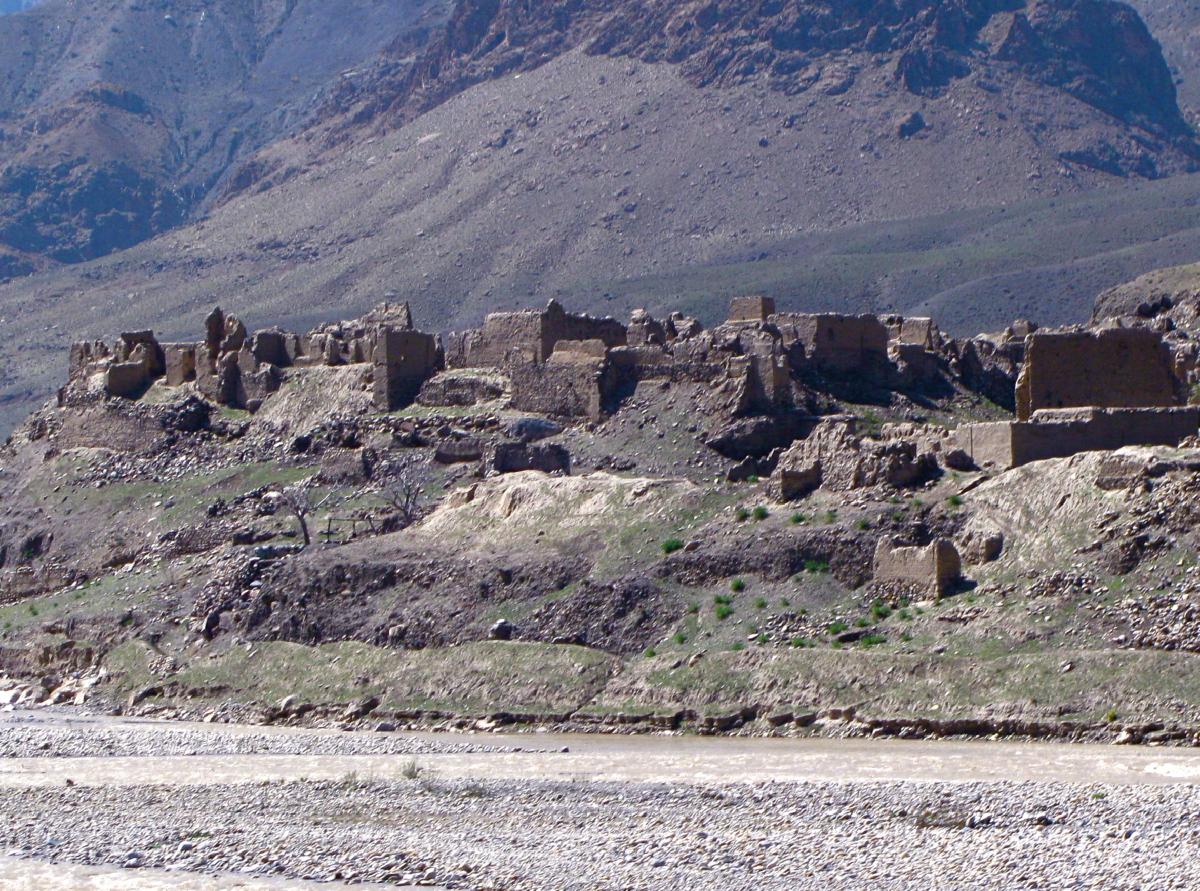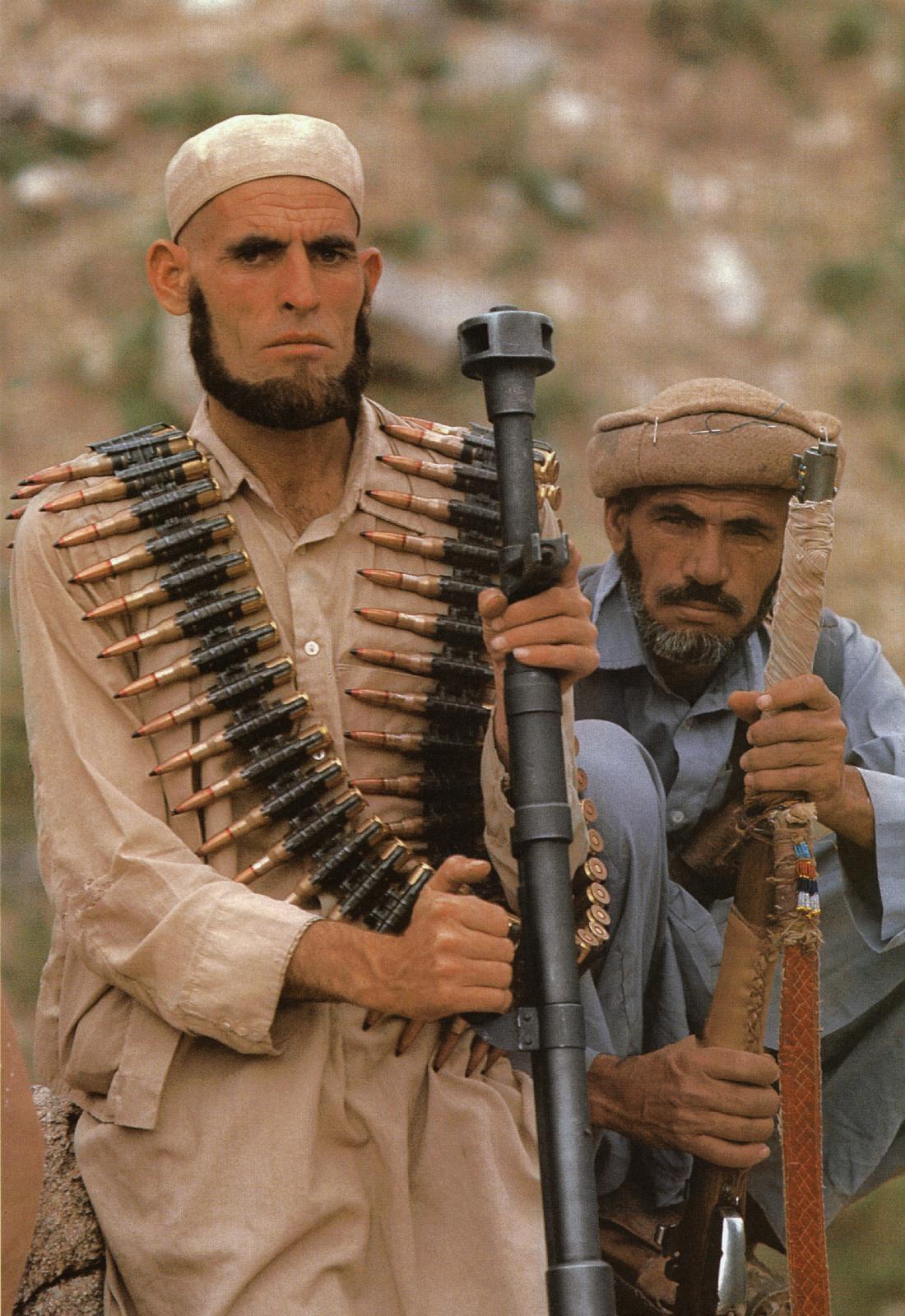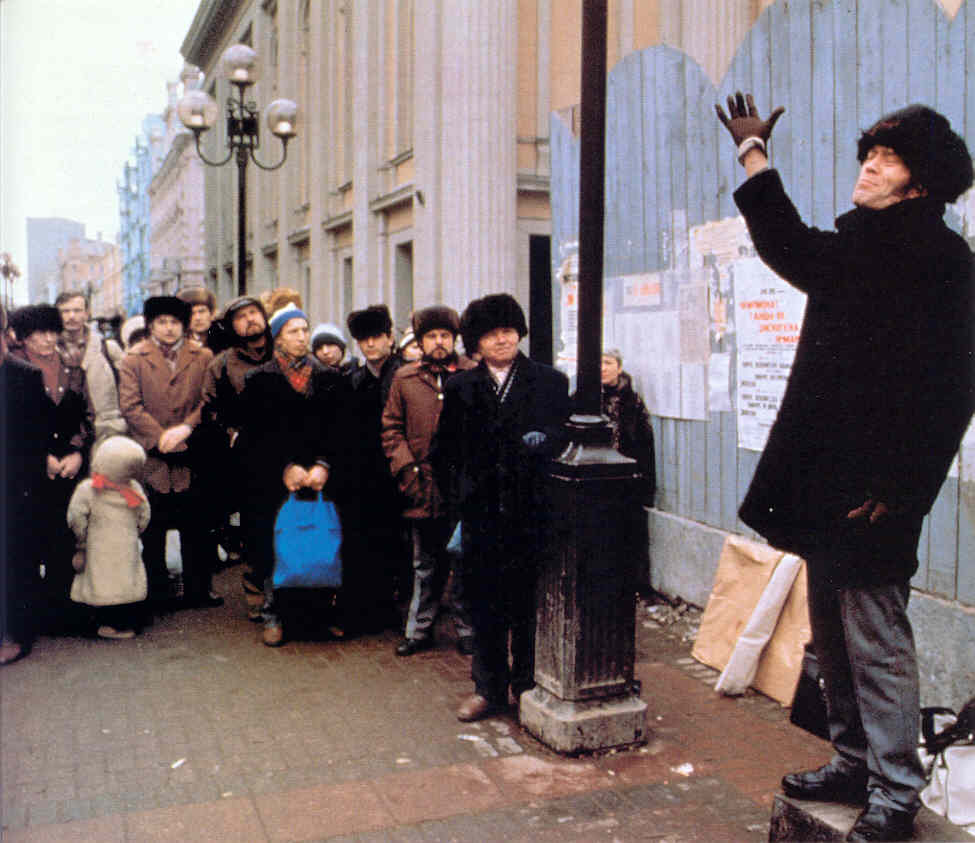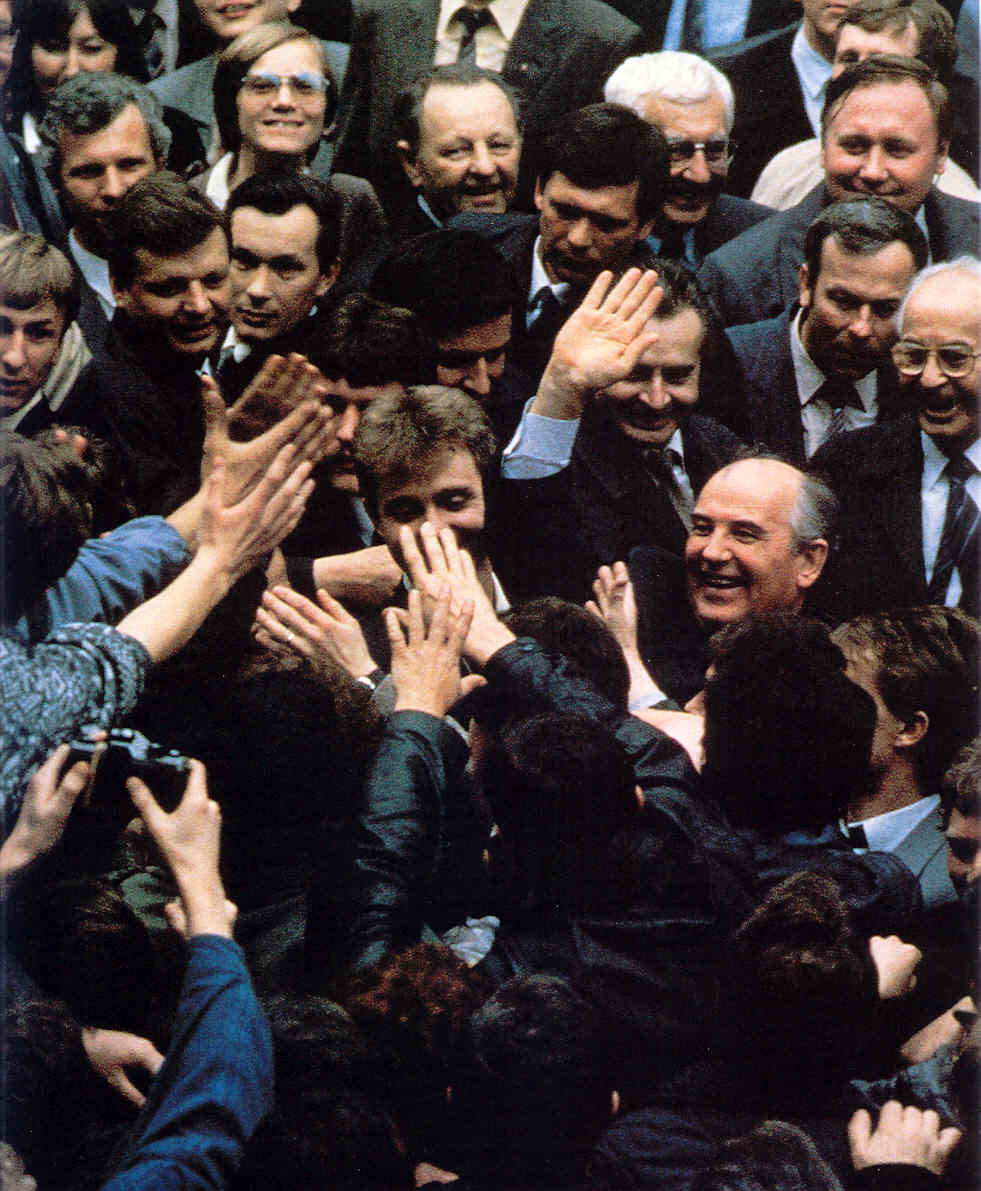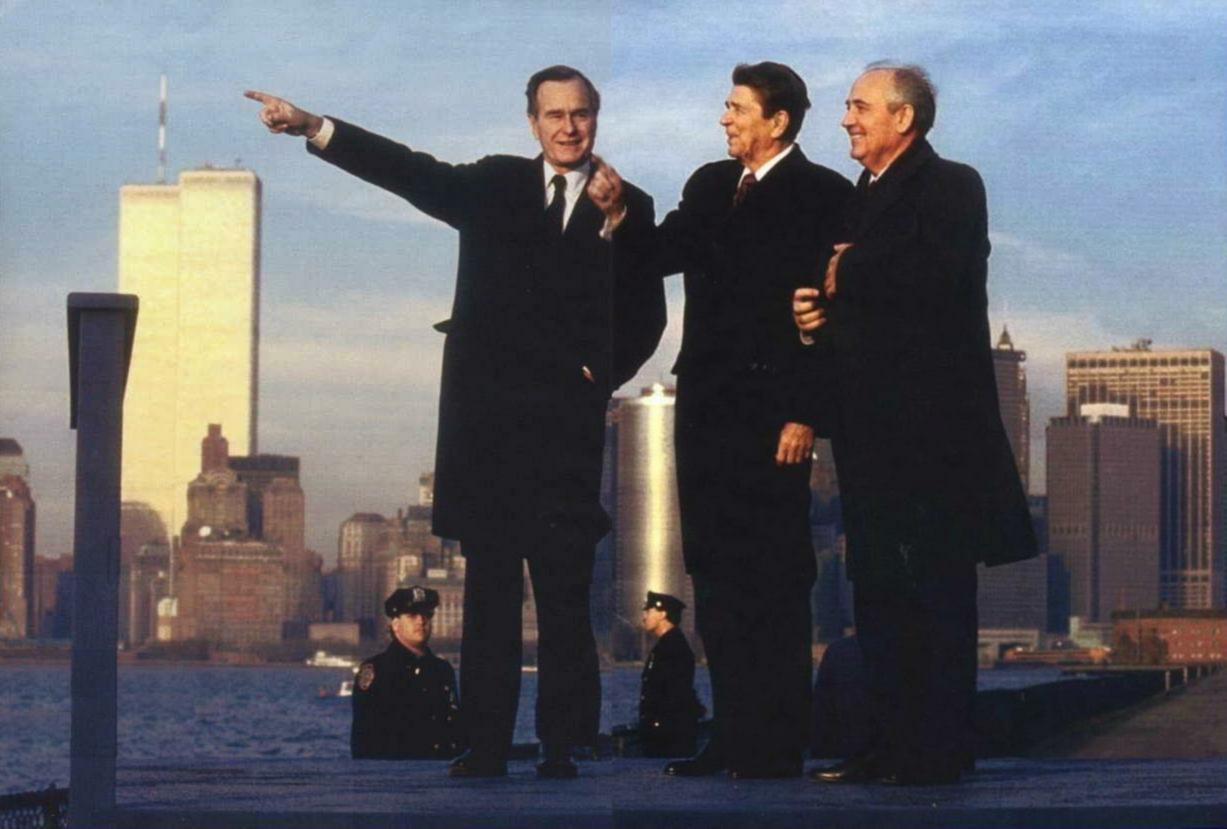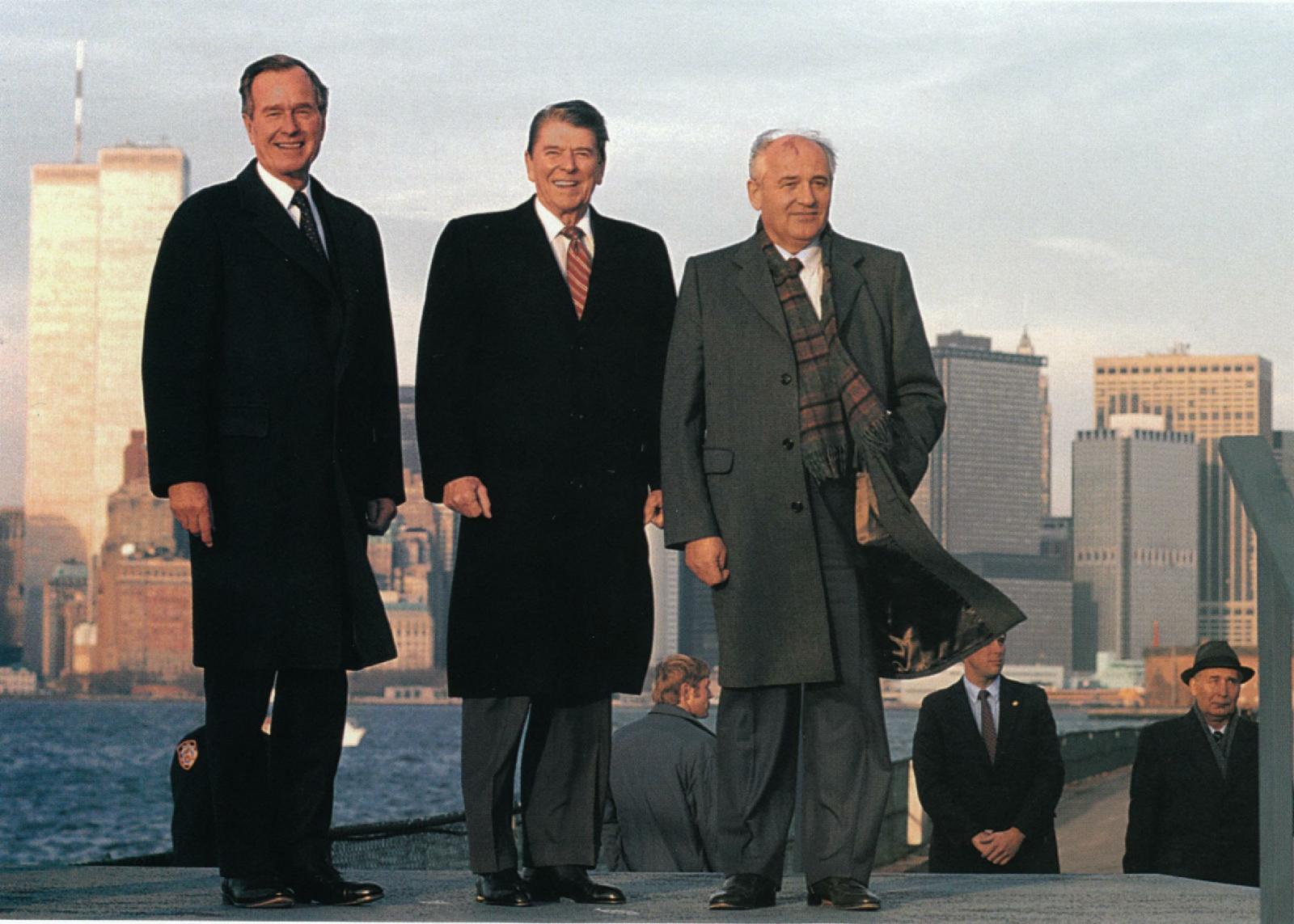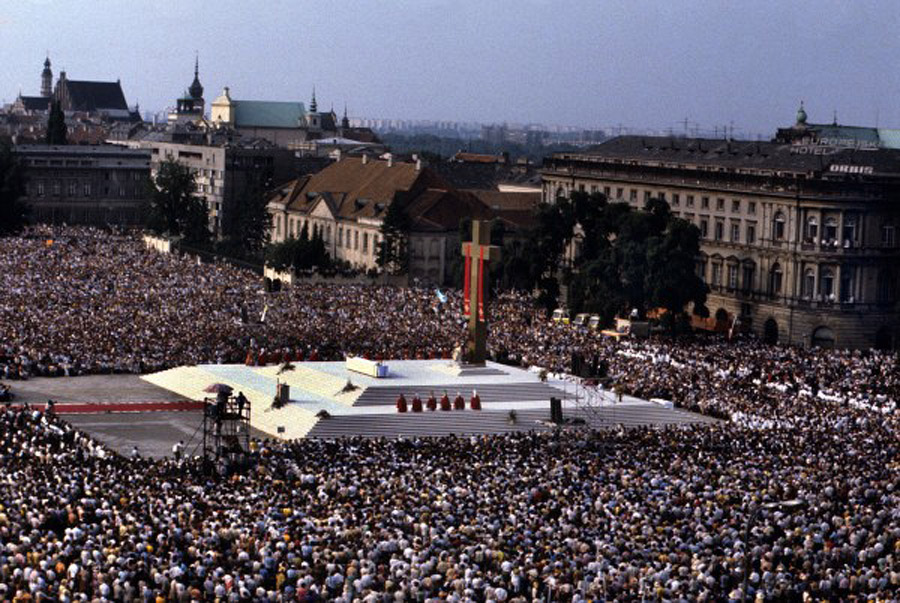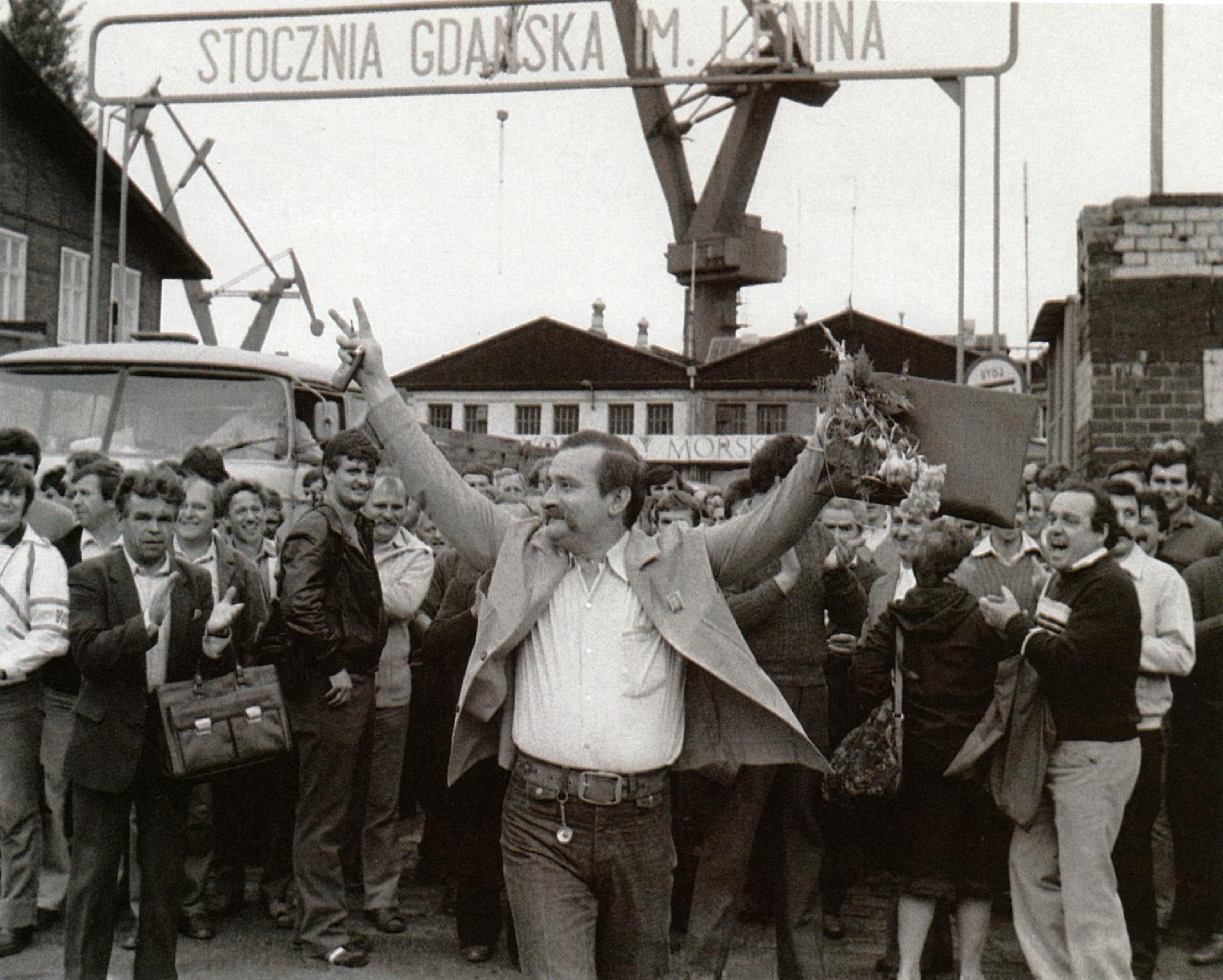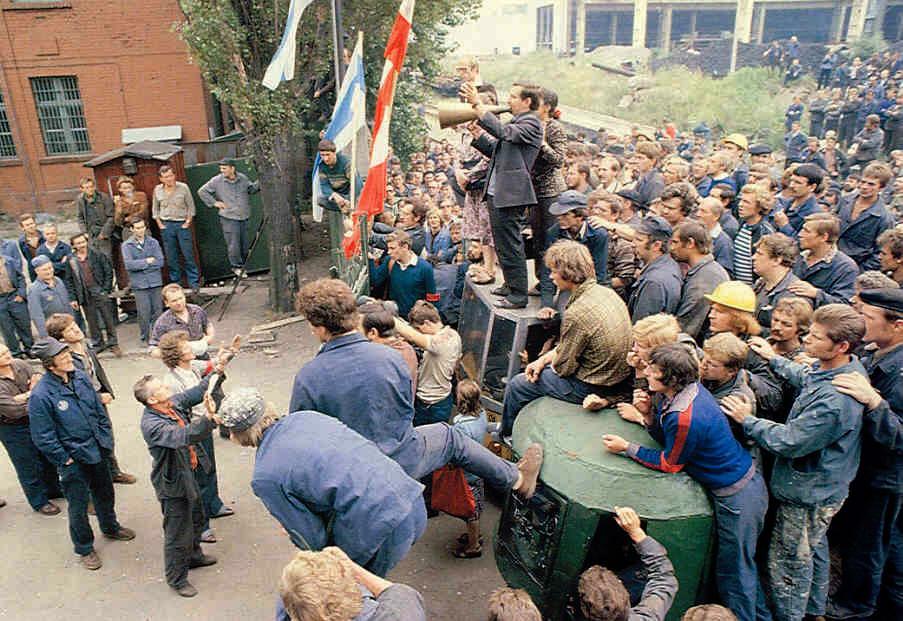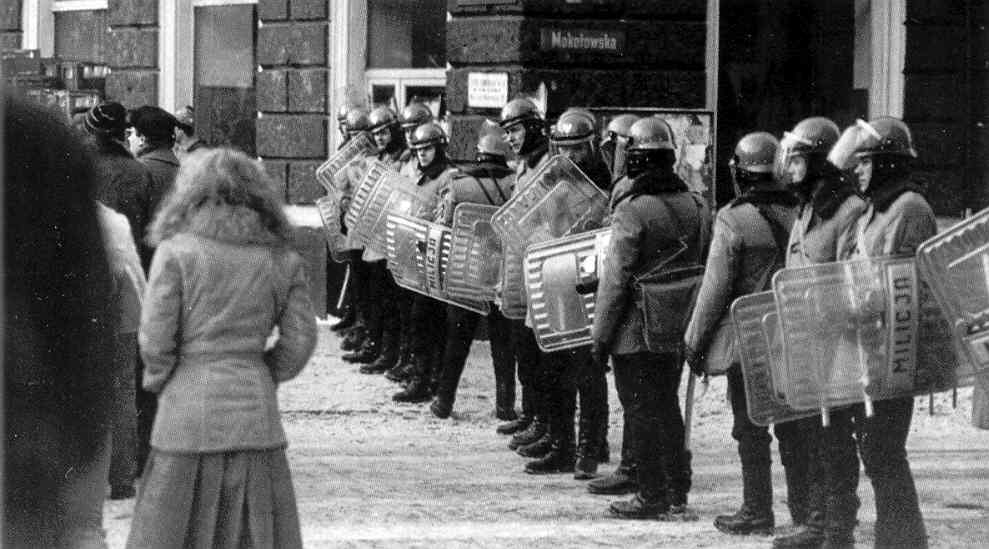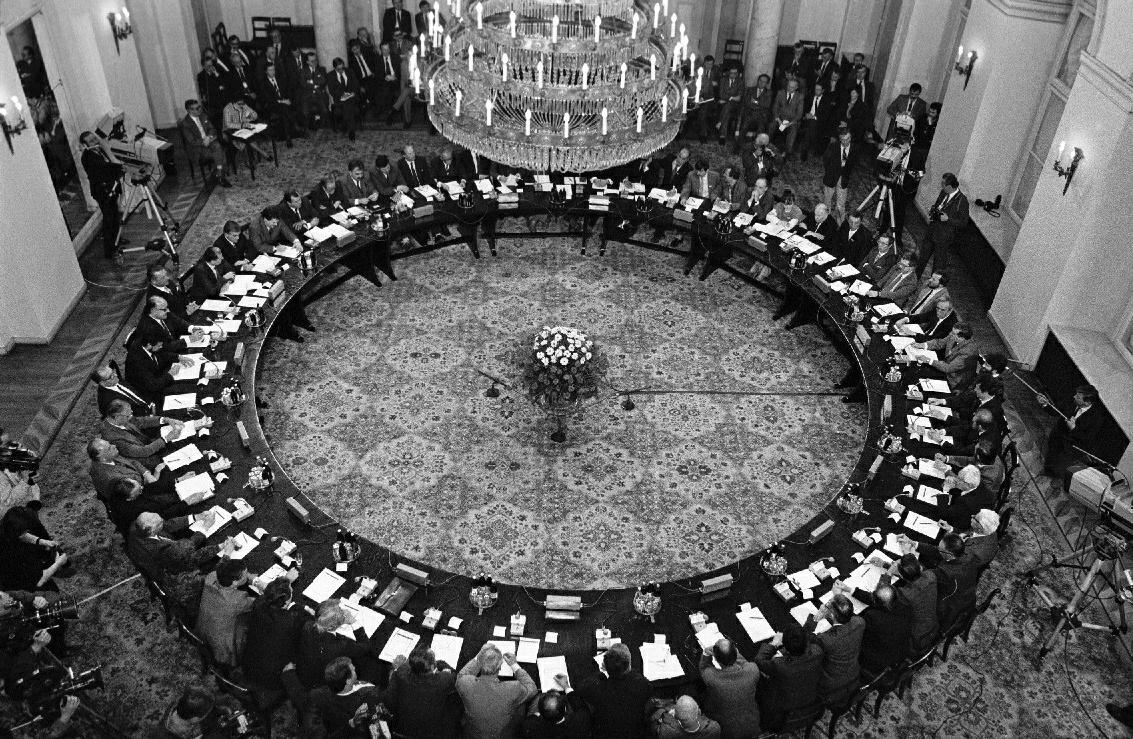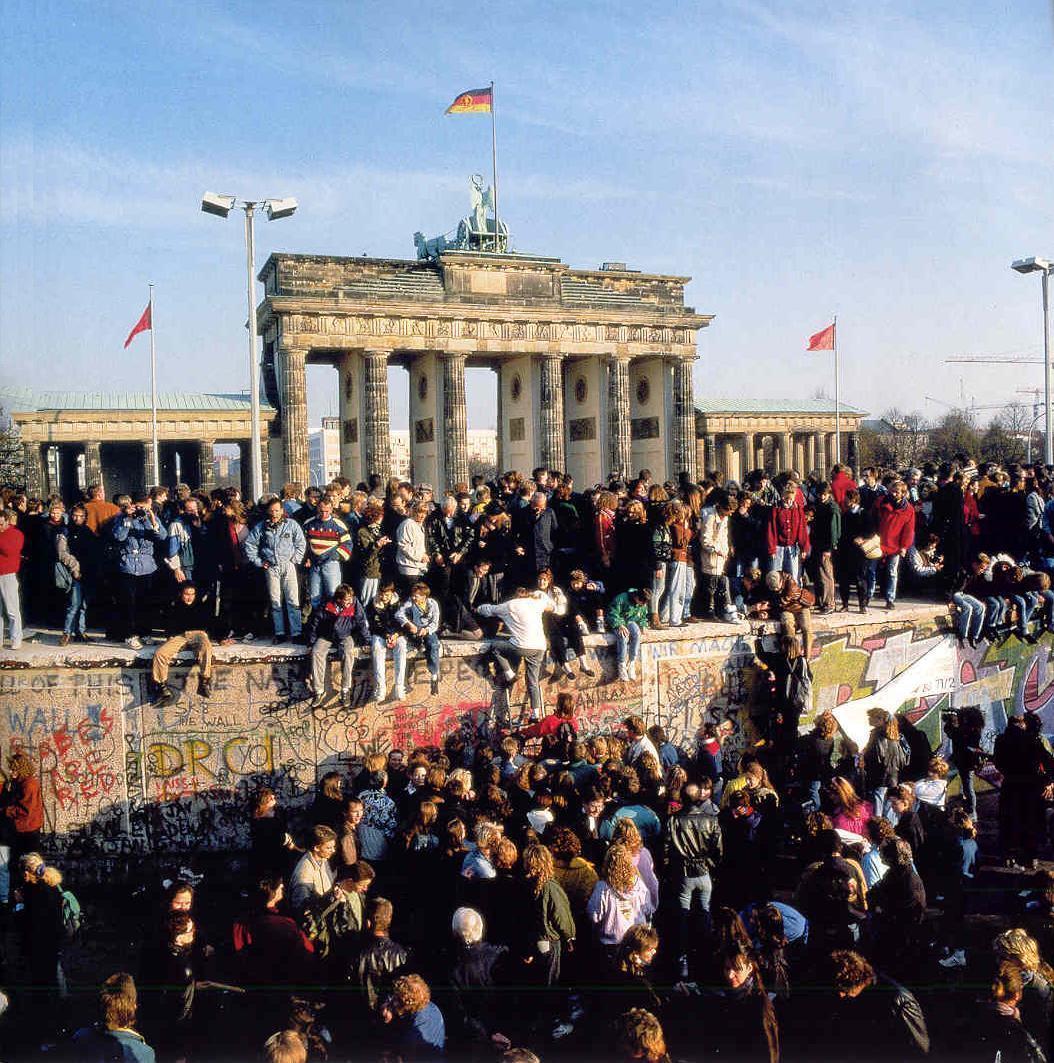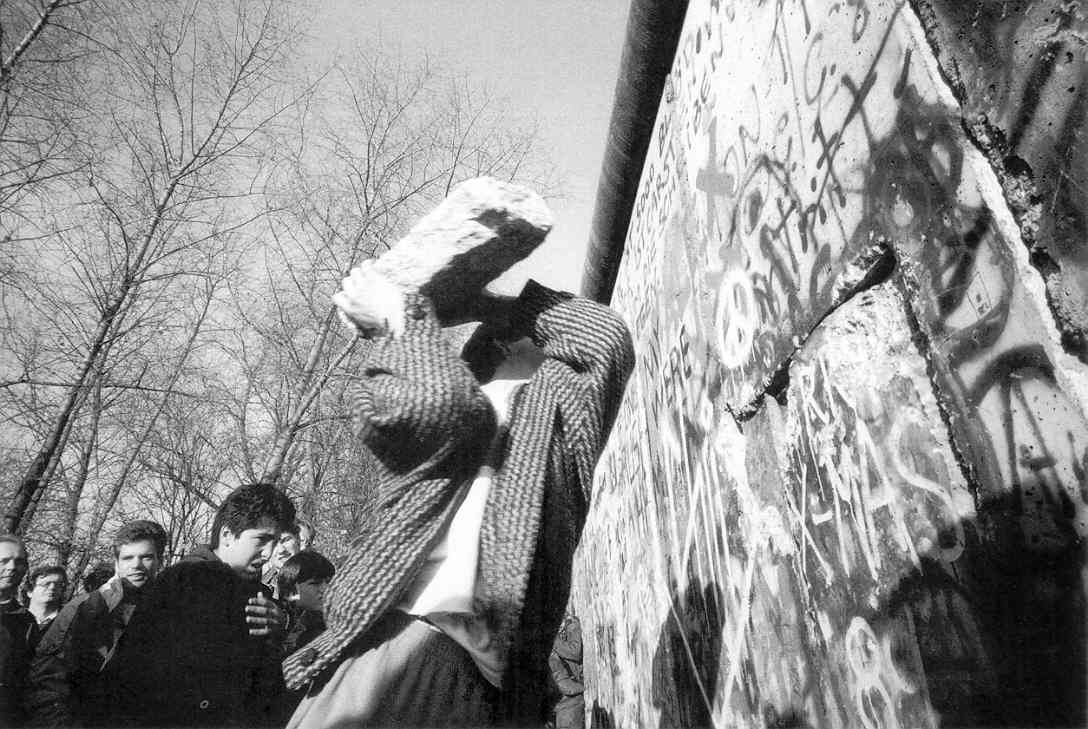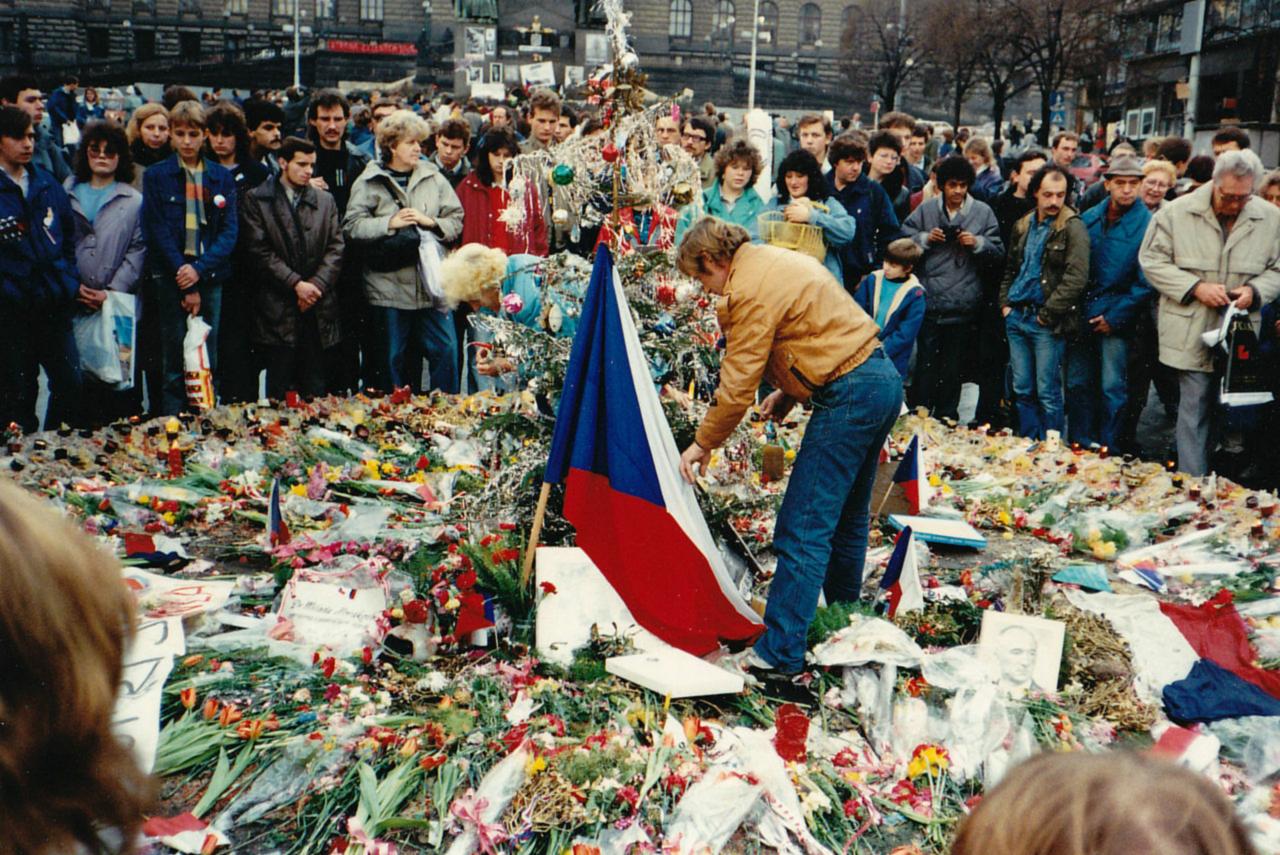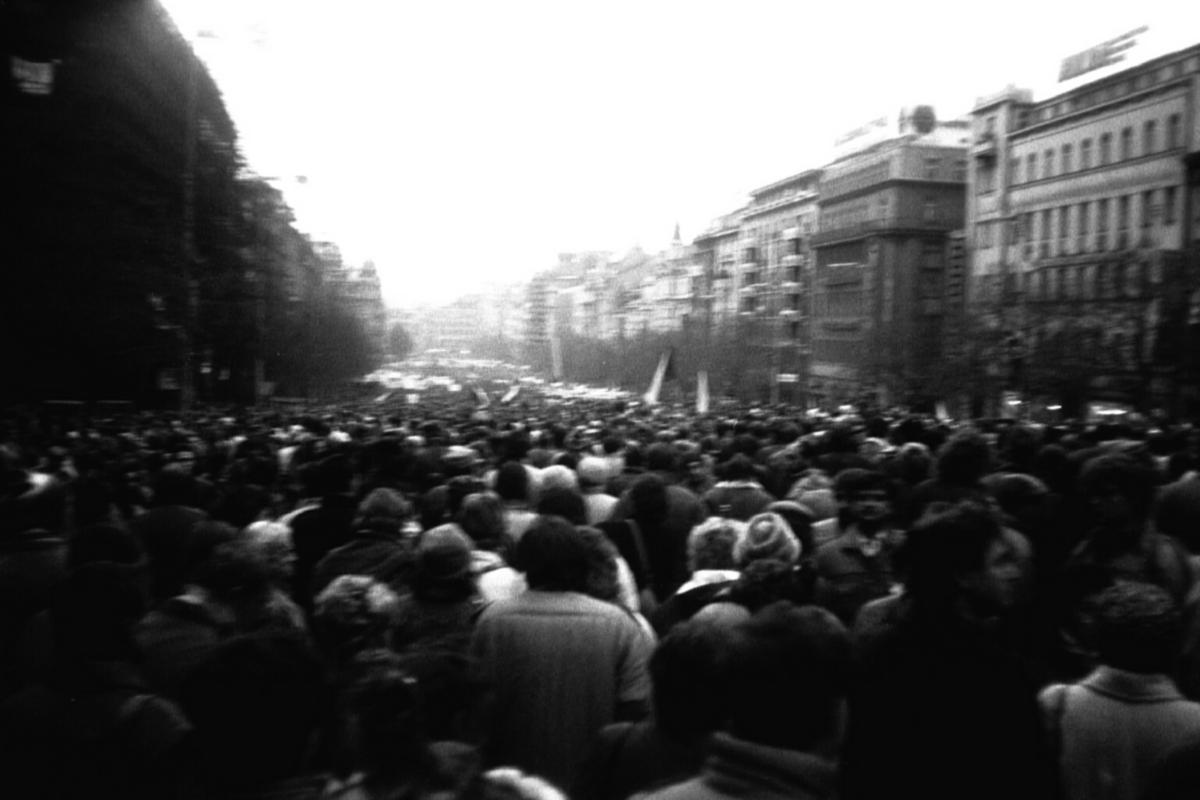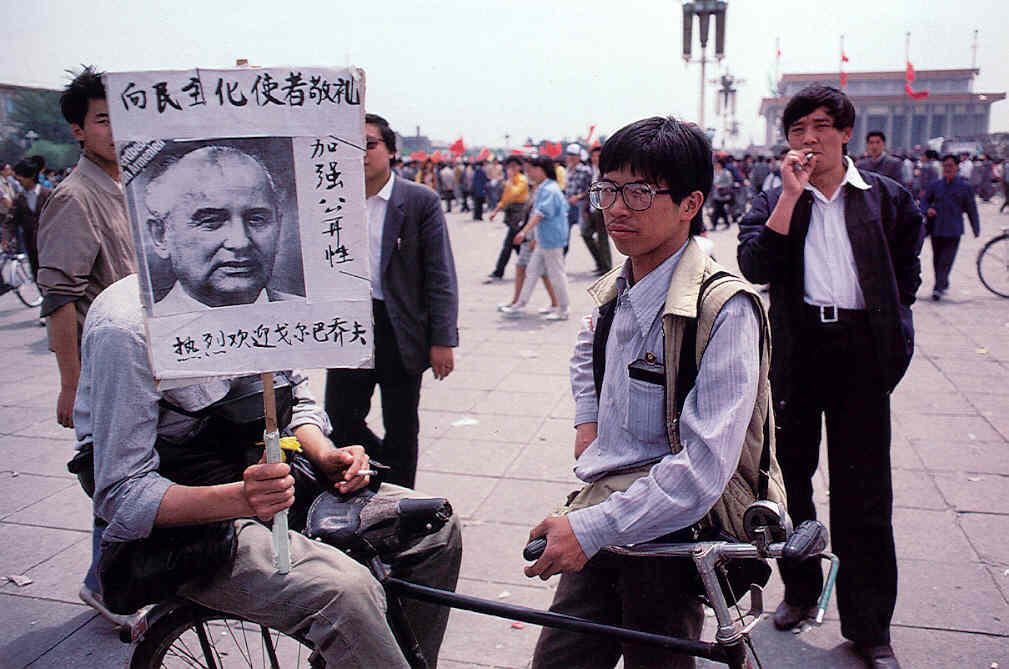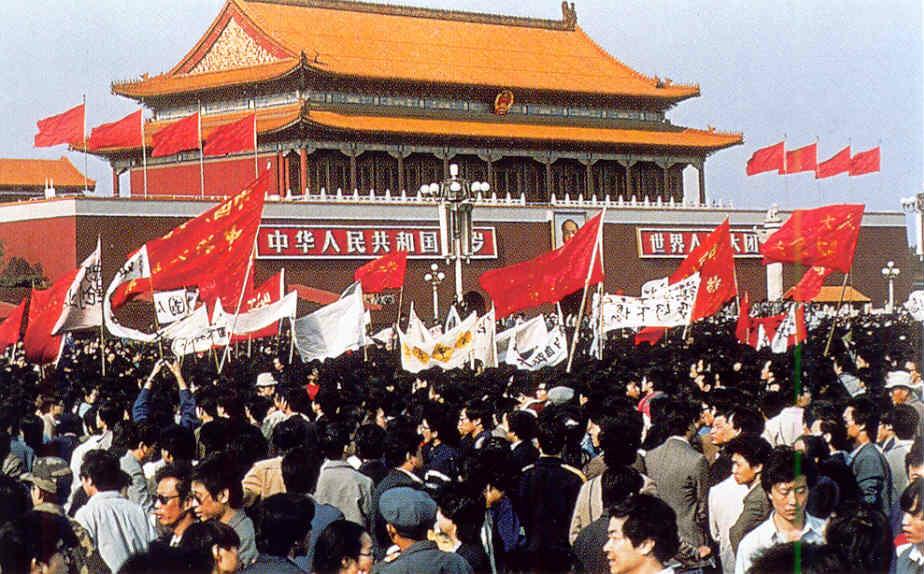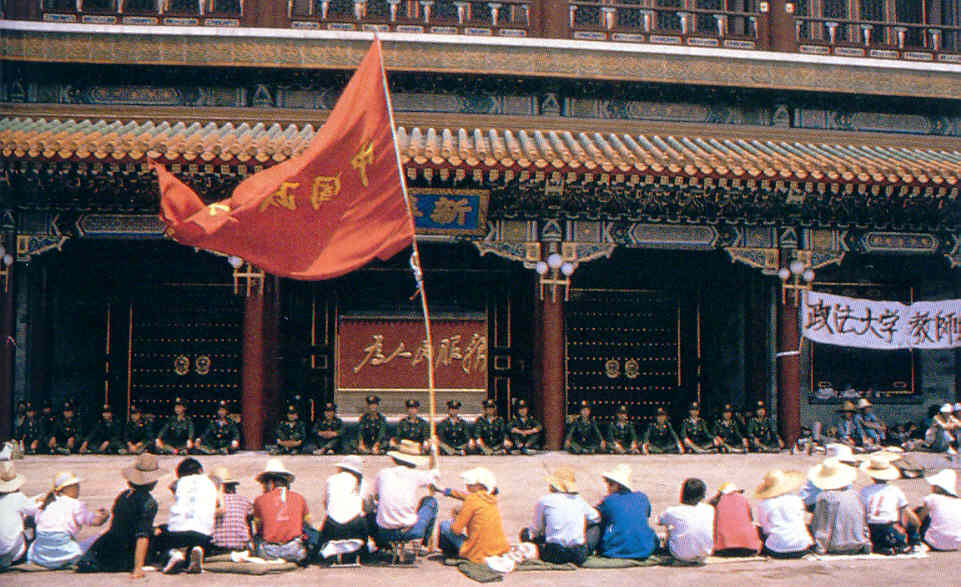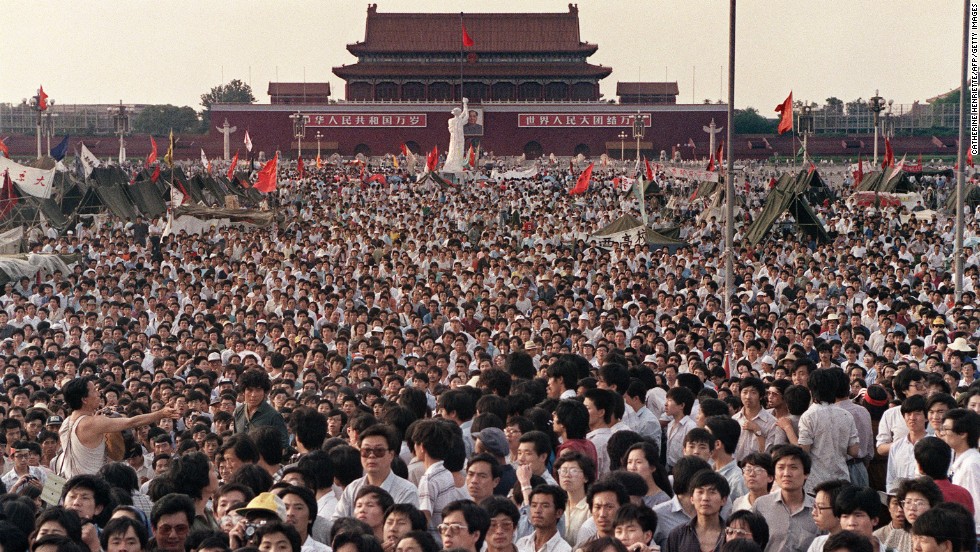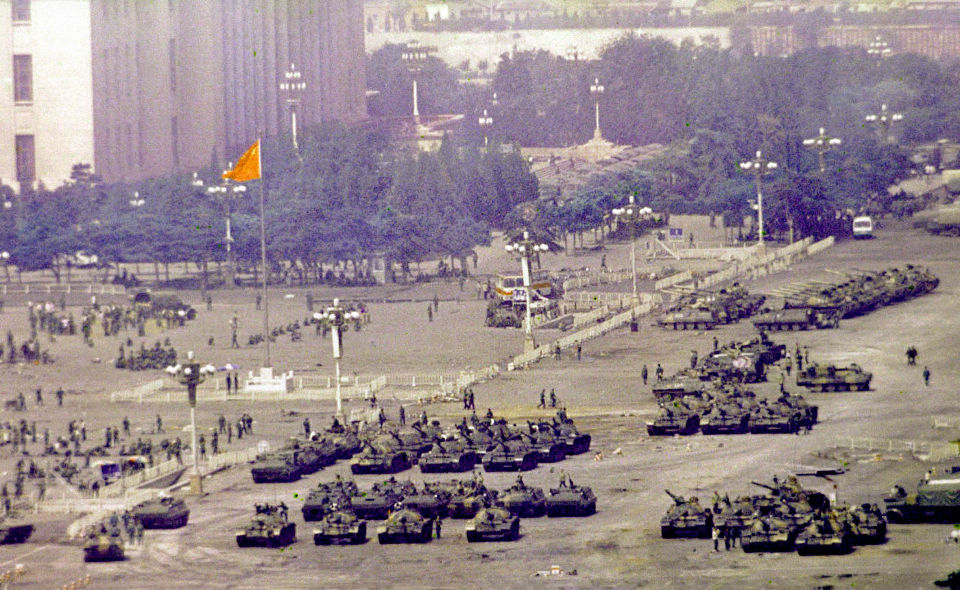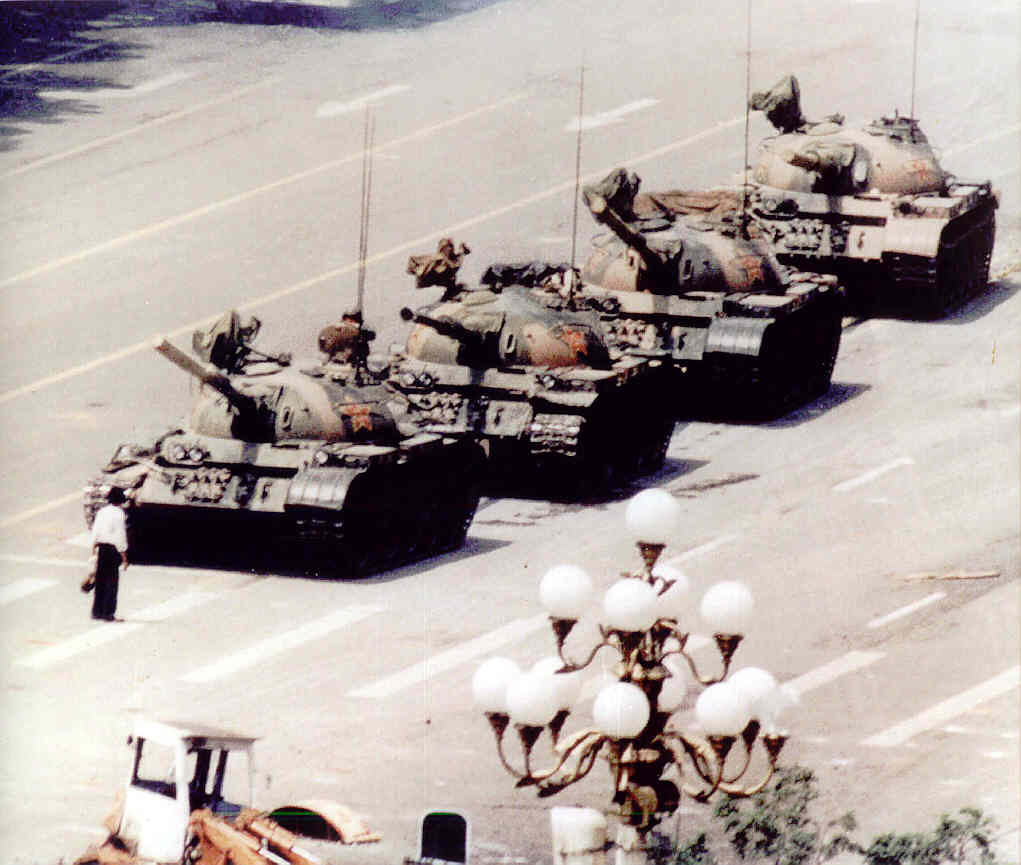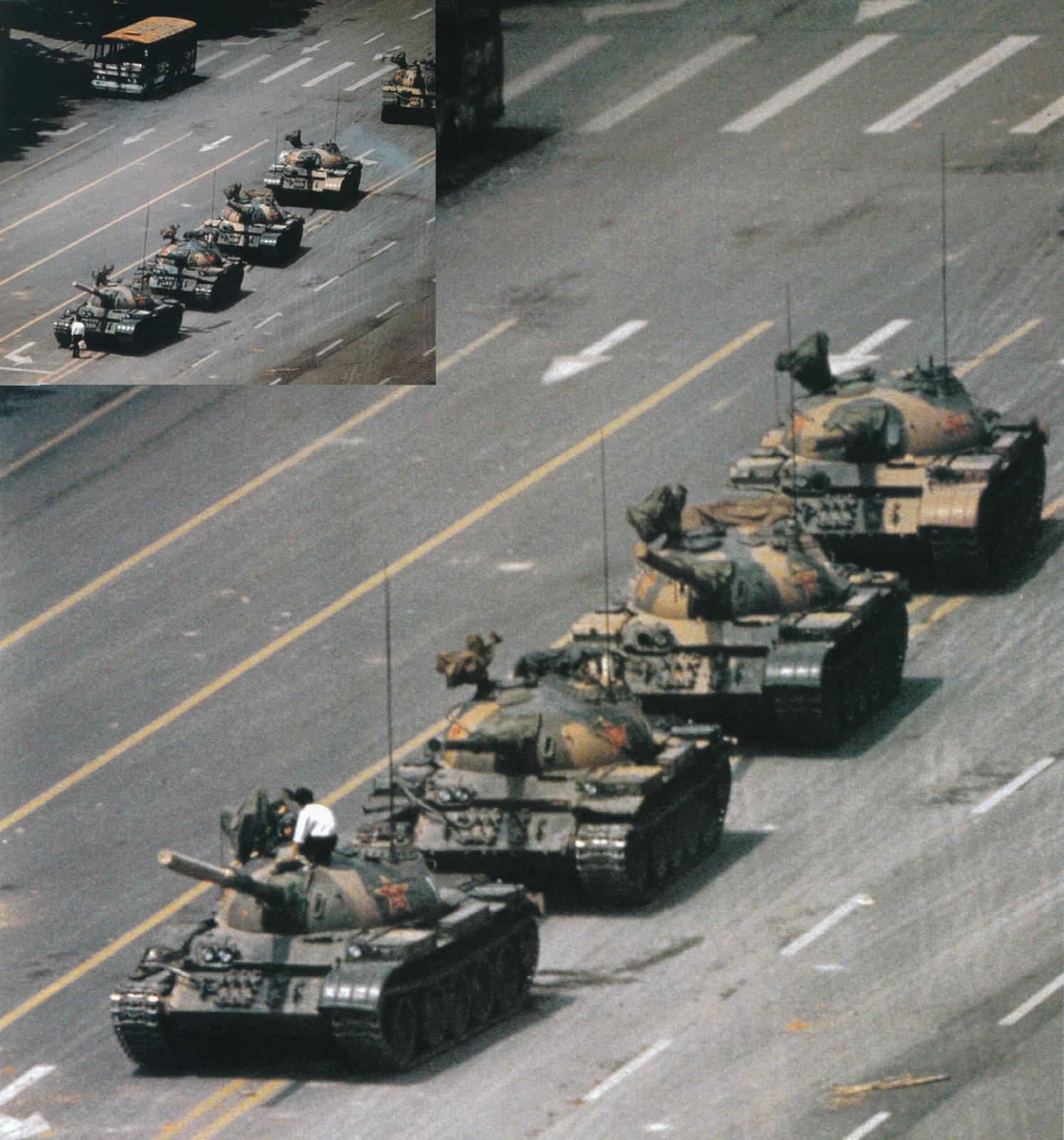20. PEACE


THE COLLAPSE OF THE SOVIET EMPIRE
 Economic, social and military problems
Economic, social and military problems
 The rapid turnover in Soviet leadership
The rapid turnover in Soviet leadership
(1982-1985)
 Collapse of the Soviet Empire in East
Collapse of the Soviet Empire in East
Europe
 The dissolution of the Soviet Union itself
The dissolution of the Soviet Union itself
 Yeltsin tries to pick up the pieces
Yeltsin tries to pick up the pieces
 China heads off a similar challenge
China heads off a similar challenge
The textual material on page below is drawn directly from my work
A Moral History of Western Society © 2024, Volume Two, pages 352-364.
ECONOMIC, SOCIAL AND MILITARY PROBLEMS IN THE SOVIET EMPIRE |
| The
reason that Reagan's popularity ratings would soon climb again was
because of his role in helping to shape developments going on in
Eastern Europe … within the Soviet Empire. Russia, once a major exporter of agricultural goods, had found that since the Soviet collectivization of Russian farms, agricultural production had dropped drastically … to a point that Soviet Russia was dependent on agricultural imports to feed its people – an expense that burdened deeply Soviet finances. Then too, the emphasis of state financial support going to the Soviet military machine left very little for the world of the individual Russian consumer. Certainly at this point the average Russian citizen was well aware of the fact that in their supposed "workers' paradise" they were falling well beyond the worker's lifestyles in the capitalist West. Consequently, worker motivation in the Soviet system was in a state of rapid decline, worsened by the absenteeism and the alcoholism that afflicted the Soviet working world. Briefly, the oil crisis that hit the world after the fall of the Shah in 1979 had boosted Soviet Russia's international earnings from its oil and gas exports … but not to the extent that the Soviet leadership felt was necessary to pull the country out of its demoralized state. As already noted, they thus dropped their export pricings in order to gain a larger share of the international oil market … only to have OPEC respond in kind – setting off a drop in oil pricings and thus earnings. This worsened deeply the social situation in Russia (as well as in the other oil exporting countries). Then too there was the matter of the Soviet military intervention in Afghanistan … in order to support a government willing to serve as a Soviet political puppet. This was undertaken in the early 1980s in the hope of producing a Soviet expansion that would put Russia at the top of a political pyramid controlling the vital Persian Gulf and its neighboring portion of the Indian Ocean – through which most of the Western world's oil supply had to pass. But the vast majority of the Afghan population had proven to be most unwilling partners in this Soviet scheme and were fighting back – with considerable American support (money and weapons) … and showing no signs of letting up in that opposition. And with these American-supplied weapons, the Afghan mujahedin were proving most able to shoot down Soviet planes and destroy Soviet tanks … running up the Soviet cost in lost military supplies and men as well as finances that the Soviets could ill afford. Indeed, the Soviets were quickly discovering what it was that America took too long to figure out with its involvement in Vietnam, namely that the huge costs involved in intervening in a most unwilling country were in no way offset by any significant gains – economic, social or political … much less military. |
Soviet paratroopers aboard
a BMD-1 in Kabul
Soviet helicopters working
with Soviet tanks in Afghanistan
Afghan village destroyed
by Soviet troops
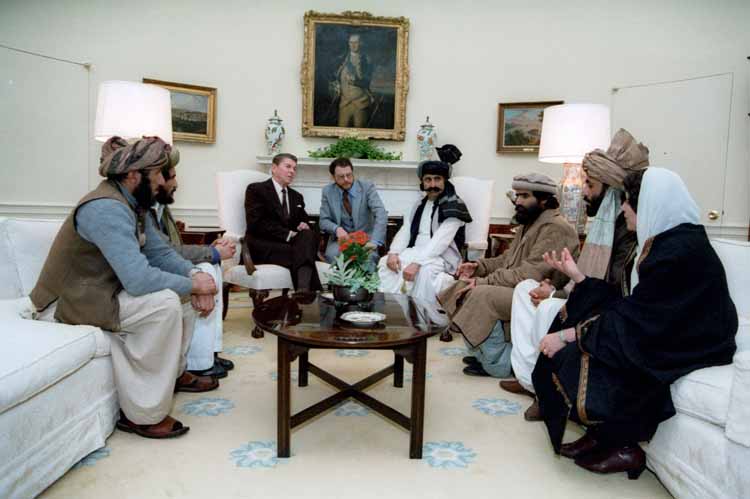
Reagan listening to the
mujahidin's
description of Soviet atrocities in Afghanistan - February 1983
Texas Congressman Charlie
Wilson in Afghanistan. Wilson was a prime mover
in Operation Cyclone, in which the US sent $ millions to support the
mujahidin in their fight against the
Soviets (unfortunately much of the money ended up in corrupt Pakistani
military hands)
Resistance by conservative Muslim mujahidin however is grinding down the Soviet effort to maintain Communist control in Afghanistan
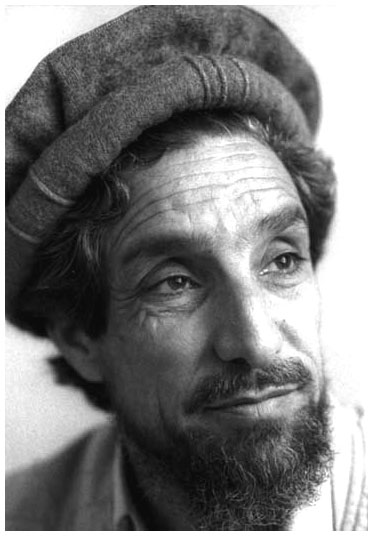
Ahmad Shah Massoud - the "Lion of Panjshir." This engineer turned mujahidin proved to the the most effective of the Afghan resistance commanders (When the Taliban later took over the country he became their prime opponent; the Taliban assassinated him just days before the September 11, 2001 attack on the New York Twin Towers)
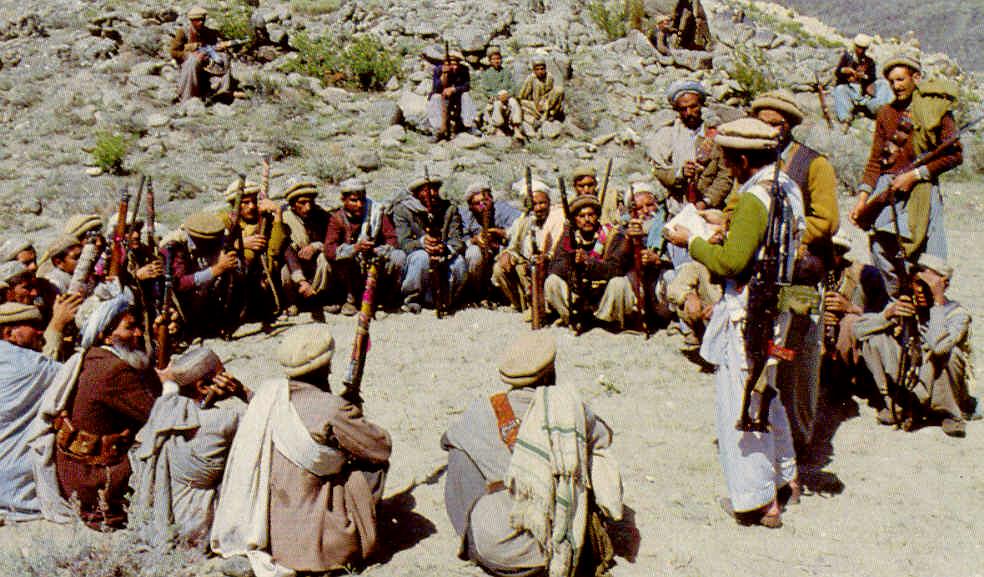
Well armed mujahedin confronting Soviet troops in Afghanistan
THE RAPID TURNOVER IN SOVIET LEADERSHIP |
| Then too, there was the matter of the rapid change in Soviet leadership that followed upon the death of Brezhnev in late 1982. The Soviet KGB head Yuri Andropov replaced Brezhnev … in the hopes of stiffening the control of the Kremlin over Russian society. But he was of poor health – and died only a little over a year after having taken the position. But the person to follow him, Konstantin Chernenko, was of no better health … and he too died only a year later. Thus it was that in March of 1985 the Soviet leadership chose a younger – but also reform-minded – individual, Mikhail Gorbachev, to take over Soviet leadership. He seemed to be greatly energized by the ideas that he had in mind to introduce as new Soviet policy, something that he was certain would put energy back into Soviet society. |
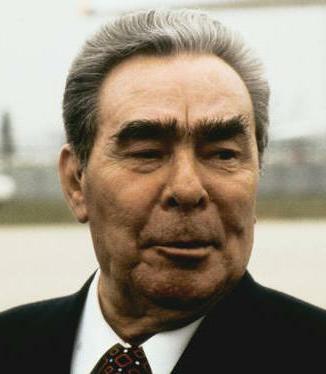
Communist Party Chairman 1964-1982
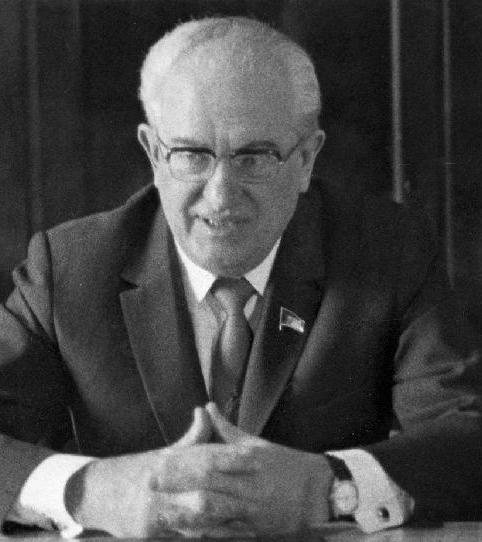
Communist Party Chairman 1982-1984
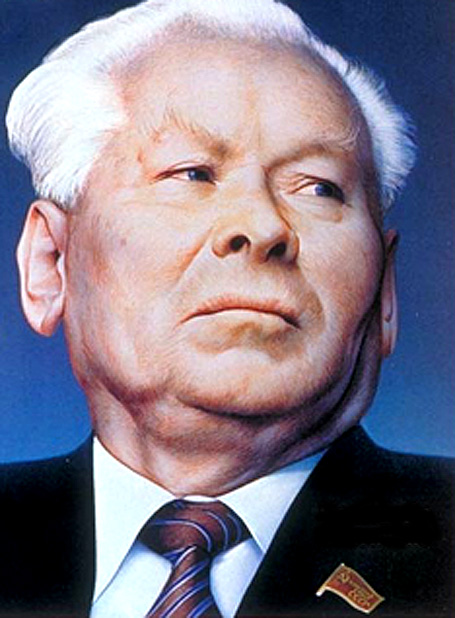
Communist Party Chairman 1984-1985
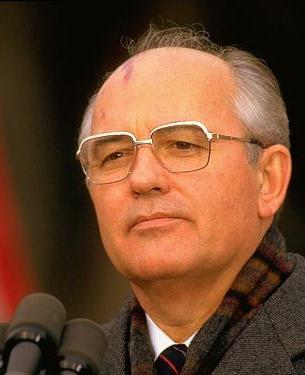
Communist Party Chairman 1985-1991
REAGAN'S "STAR WARS PROGRAM" |
| This
need to re-energize Soviet society was especially the case given the
clear intention of American president Reagan to challenge the Soviet
Empire in every way possible. Back in 1982 in a speech that Reagan had
delivered before the British Parliament, he made it clear that he was
dedicated to pushing the Soviet "Evil Empire" to the point of collapse.
And Reagan quickly followed this up by putting the B1-Bomber program
back into operation (after Carter had canceled it), then by arming NATO
with American Pershing II missiles … and in 1983 announcing a Strategic
Defense Initiative (SDI) that would develop laser-guided missiles able
to knock down incoming Soviet missiles – effectively ending the Soviet
nuclear deterrent. Unsurprisingly, an "anti-imperialist" (Democratic-Party-controlled) Congress was most unwilling to support the expensive and supposedly unneeded SDI program. Senator Ted Kennedy had even mocked Reagan's program as being nothing more than "reckless Star Wars schemes" … offering a nickname for the program which Regan himself was willing to accept! But as things turned out, the "Star Wars program" would not be needed … because the Soviet Empire itself had crumbled before even the end of the 1980s decade. |
He challenges the cash-short Soviets to another round in the arms race with the introduction of the "Star Wars" strategy
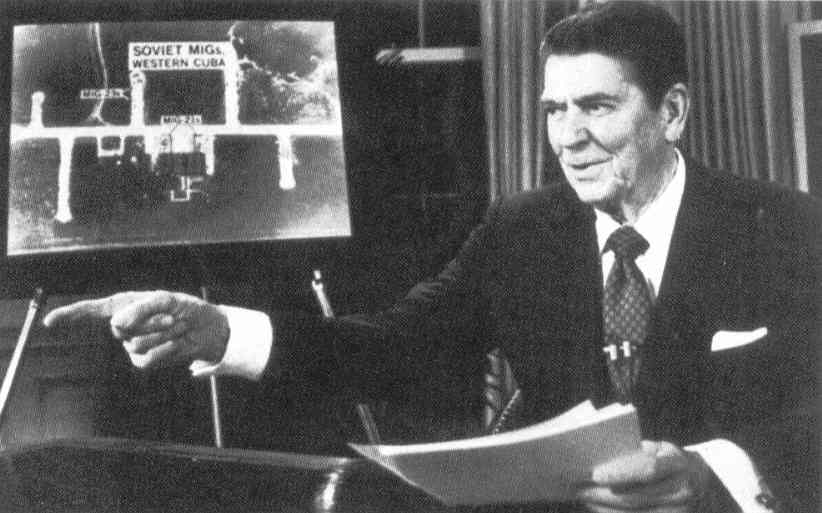 In a televised speach, Reagan
reveals his Strategic Defense Initiative or "Star Wars" plan
March 23,
1983
In a televised speach, Reagan
reveals his Strategic Defense Initiative or "Star Wars" plan
March 23,
1983GORBACHEV'S REFORMS |
| In
1986 Gorbachev began to introduce his reforms, glasnost (a new openness
in the society), perestroika (a restructuring of the economic system)
and demokratizatsiya (democratization of the political system). His
hope was that these reforms would put the Russian citizens back to work
supporting the advancement of their society and its long-dreamed-of
social revolution. Indeed, these reforms were met with great enthusiasm … in Russia itself, of course – but also in the countries of the East European Soviet Bloc. But what Gorbachev did not realize was that these reforms also set loose a revolution of its own … a "revolution of rising expectations" in which these new steps into a world of greater political freedom would merely develop strongly the expectations for even greater freedom – well beyond what Gorbachev himself was ready to agree to. Then too there was the back-and-forth in the relationship between Gorbachev and his most important rival, Reagan. In so many ways Reagan wanted to support Gorbachev in his reform efforts. The two men met together often to share ideas and hopes. But still, Reagan could be very challenging in this matter … at one point standing in front of the wall in Berlin and telling Gorbachev (and the watching world): . . . if you truly want peace and liberalization, Mr. Gorbachev, open this gate! Mr. Gorbachev, tear down this wall! |
Gorbachev was pushing for a new face to Communism with the policies of perestroika and glasnost.
A Russian practicing
glasnost
on a Russian street
Gorbachev welcomed in Prague
for his reforms
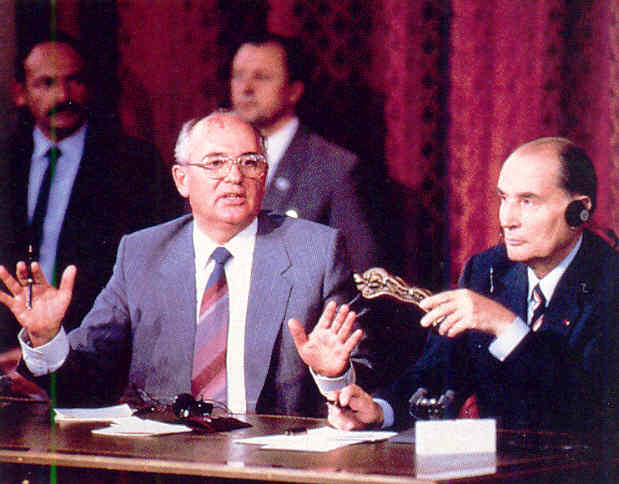 Soviet Premier Gorbachev
meets with French President Mitterrand in Paris
Soviet Premier Gorbachev
meets with French President Mitterrand in Paris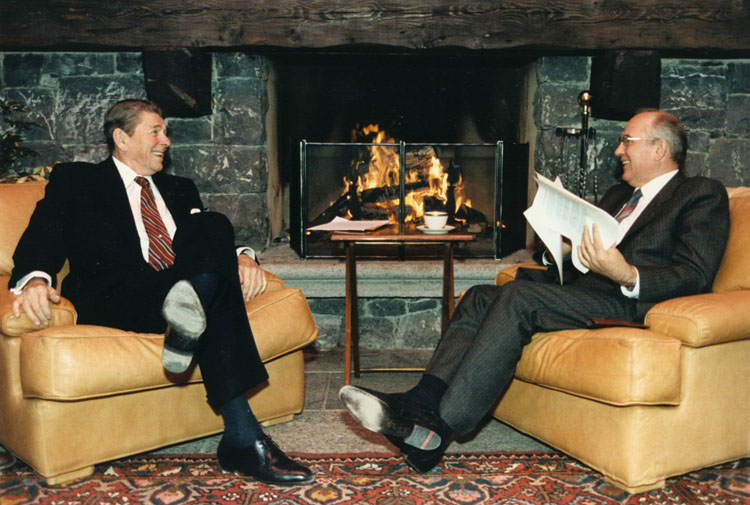
Reagan and Gorbachev at the
first Summit in Geneva, Switzerland - 19 November 1985
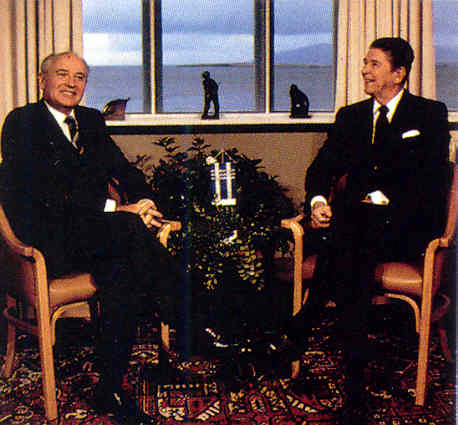 Gorbachev and Reagan meet
in Reykjavik, Iceland - autumn 1986
Gorbachev and Reagan meet
in Reykjavik, Iceland - autumn 1986
But despite Gorbachev's moves to institute political reforms Reagan was still insistant: the Berlin Wall (and all it symbolized) had to come down
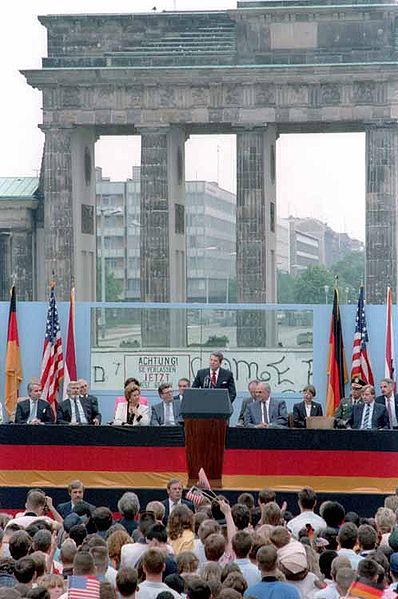 "Mr. Gorbachev, tear down
this wall!" - June 1987
"Mr. Gorbachev, tear down
this wall!" - June 1987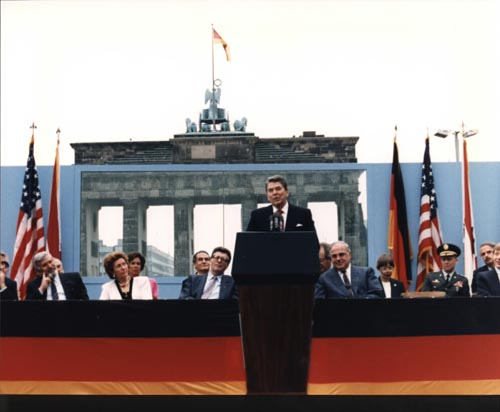
But Reagan's and Gorbachev's relationship remains quite positive
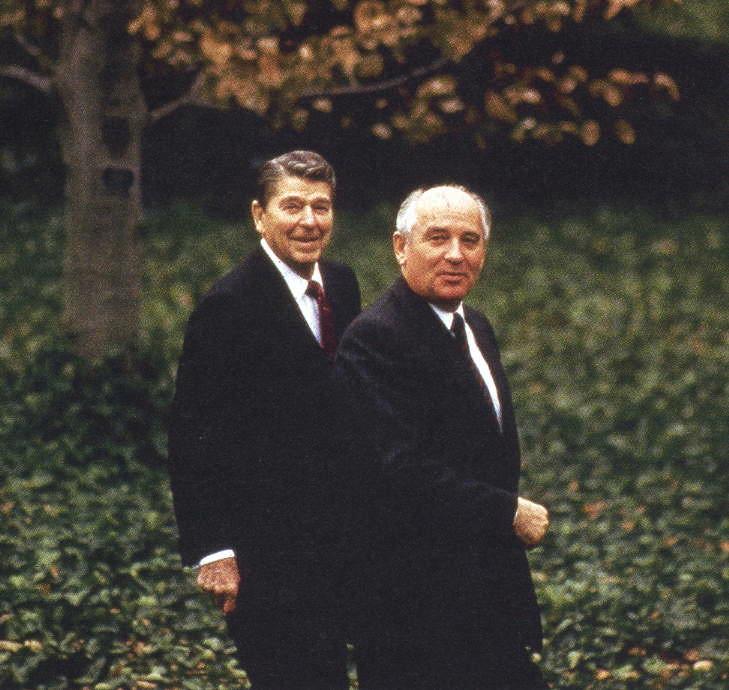
Gorbachev with Reagan on
a summit visit to Washington - 1987
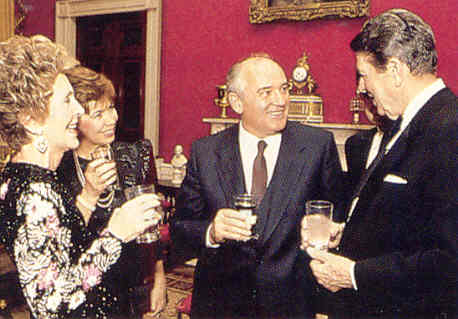
The Gorbachevs visit the
Reagans in Washington - December 1987
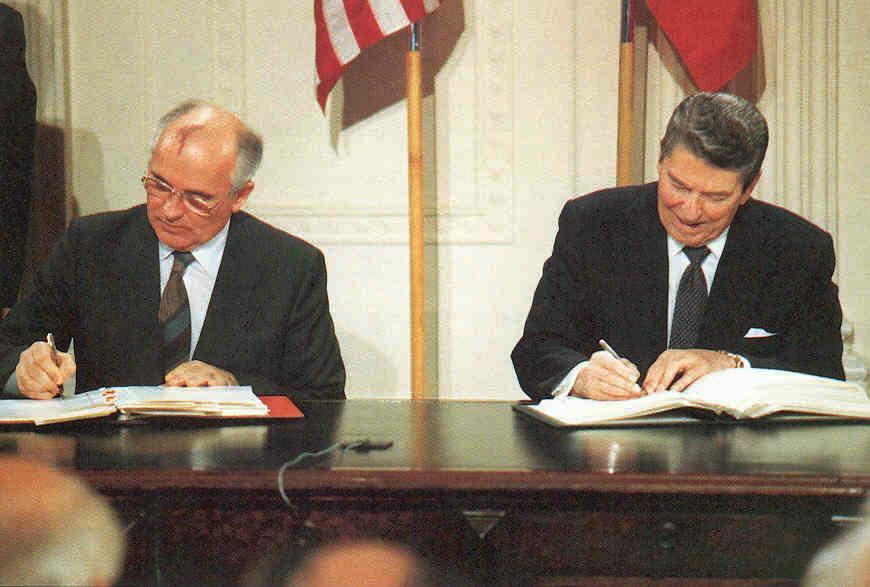
Gorbachev and Reagan sign
the Intermediate Nuclear Forces (INF) Treaty in Washington - 1987
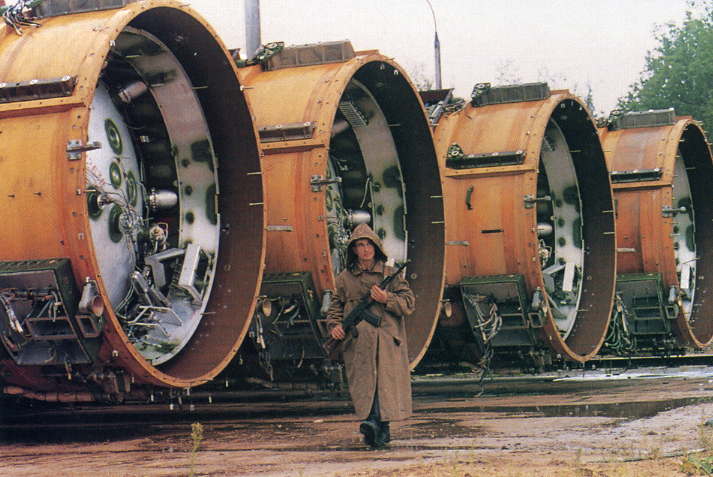
A Soviet sentry guarding
ICBMs scrapped under a 1987 disarmament treaty with the US
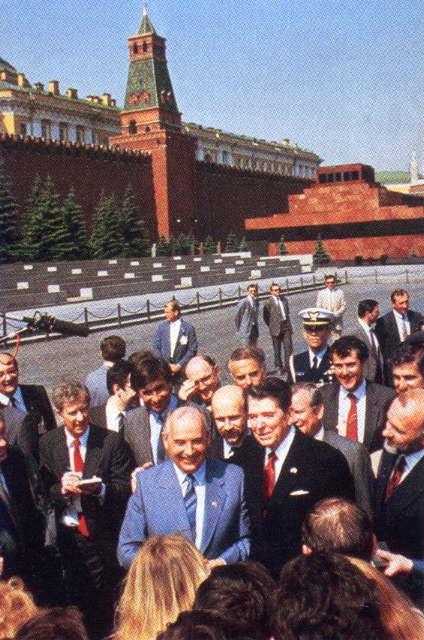
Gorbachev and Reagan in Moscow
- 1988
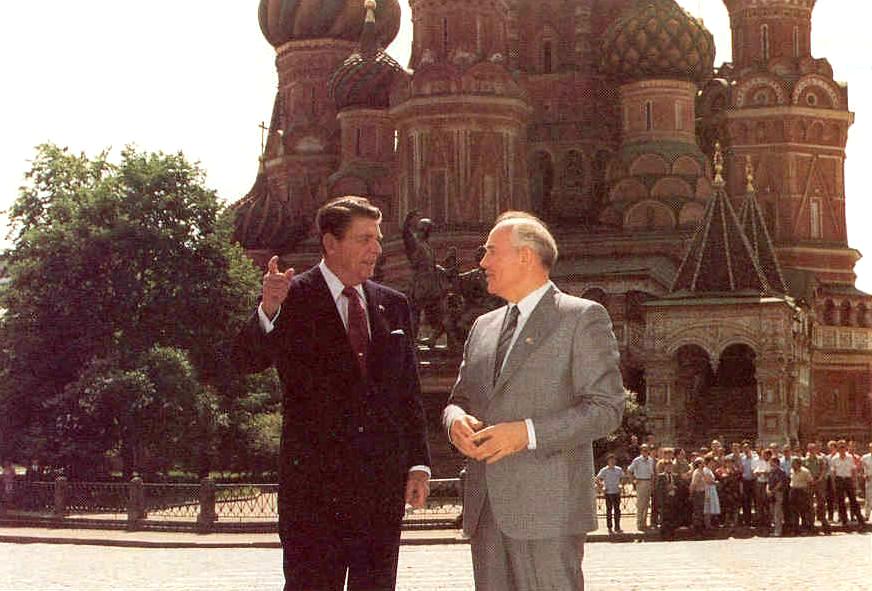
President Ronald Reagan visiting
with Soviet Premier Mickail Gorbachev in Moscow, chatting in front of St.
Basil's Cathedral on Red Square
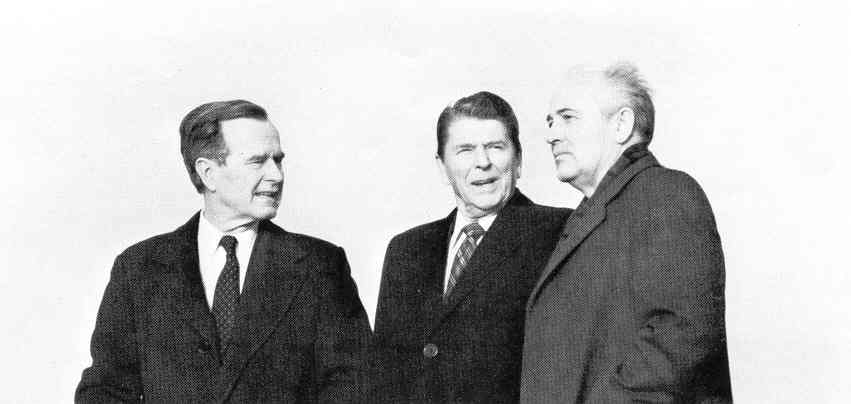
George Bush and Ronald Reagan
meet with Mikhail Gorbachev in New York in 1988
Soviet Premier Gorbachev
visiting Reagan and Bush in New York shortly after the latter's
electoral victory in 1988
BUSH TAKES REAGAN'S PLACE |
| But
at this point, Reagan's eight years in office were coming to a close …
and his place was taken by his Vice President of those eight years,
George H. W. Bush. It had been a fairly easy Bush victory in November
(1988) over his Democratic Party rival, Massachusetts Governor Michael
Dukakis … Bush gaining 53.4 percent of the popular vote to Dukakis's
45.6 percent and 426 Electoral College votes to Dukakis's 111 votes. And although Bush had little to do with what was about to develop within the Soviet Empire, those developments would become a big part of the larger political picture during the Bush years (January 1989 to January 1993). |
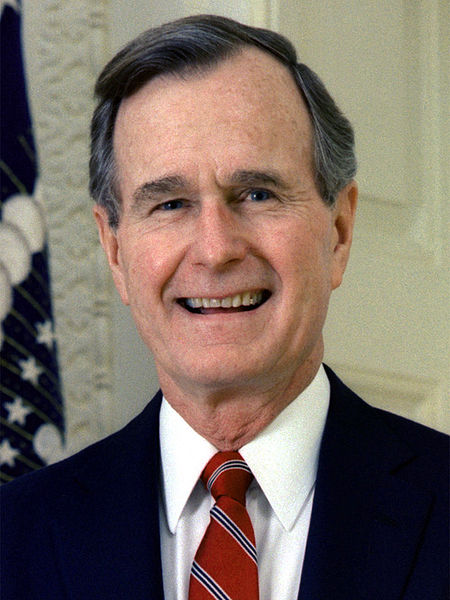
The 1988 presidential candidates: George H.W. Bush (Republican) and Michael Dukakis (Democrat)
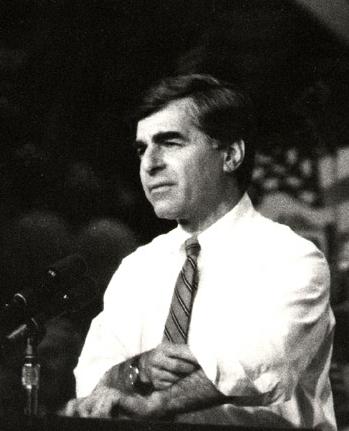
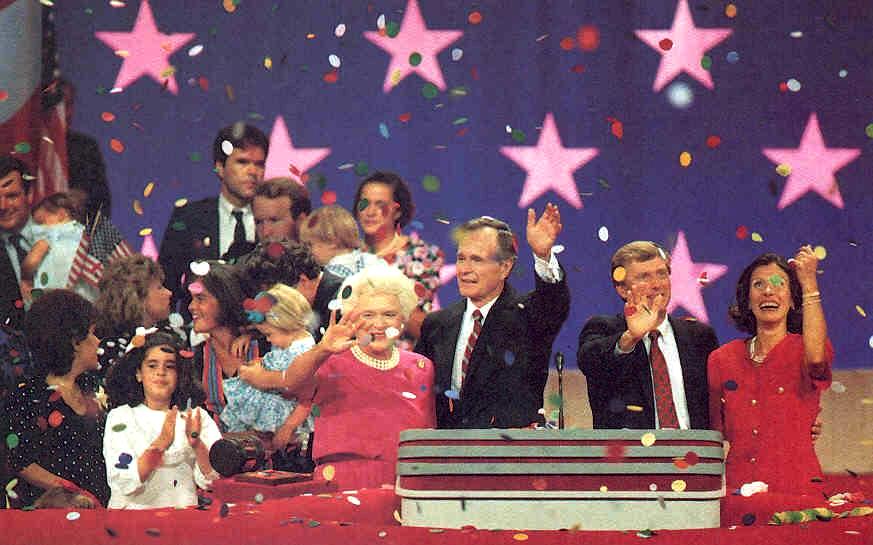
George Bush and Dan Quayle
nominated by the Republican Party Convention - 1988
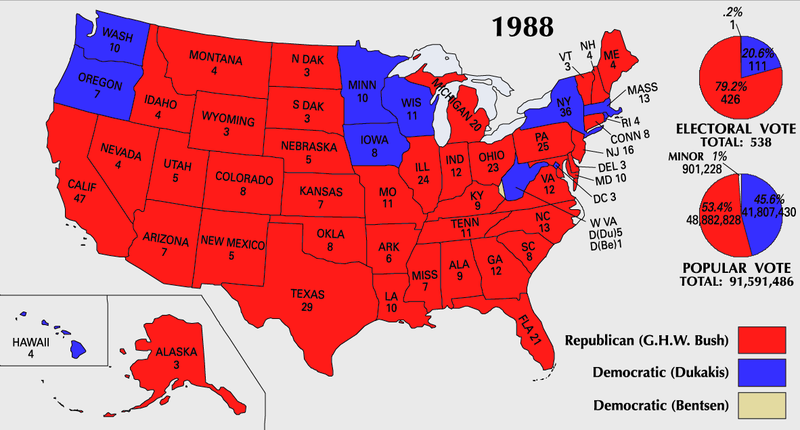
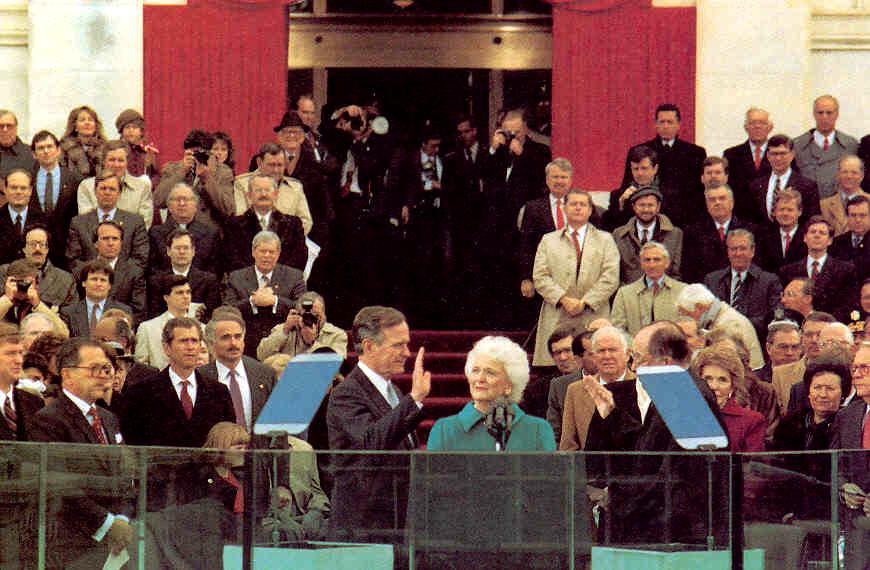 George Bush sworn in as the
41st president of the United States
George Bush sworn in as the
41st president of the United States
THE COLLAPSE OF THE SOVIET EMPIRE IN EAST EUROPE |
|
Polish reforms get things moving (1989)
Events that would finally bring down the Soviet Empire in Eastern Europe had their beginnings in Poland … where demands for reform reached all the way back to the beginning of the 1980s. It started there with the creation in 1980 of a Polish worker's organization, "Solidarity" – under the skillful leadership of the worker-leader Lech Wałęsa – when workers' wages had fallen well behind the inflation set loose by the international oil crisis. Agreement by the Polish government to recognize this workers' movement opened the doors for wider demands for social reforms … which once underway got harder and harder for the Polish Communist authorities to manage. Polish military action in 1981 led by General Wojciech Jaruzelski was called on … as preferential to having the Soviet Russian military do the job of bringing things back under Communist control. But ultimately, Solidarity held together – with secret help from America … and very open encouragement coming from the Vatican's Polish Pope John Paul. Finally in 1989, discussions – plus Gorbachev's stand in favor of social reform – produced an agreement in April between Solidarity and the Jaruzelski Communist government for partially free parliamentary elections to be held in June. The results were a huge blow to the Communists. They of course got their preassigned 65% seating in the Sejm … but Solidarity got all but one of the 100 Senate seats – all of which had been open to free competition. Nonetheless, based on their majority in the Sejm, the Communists were the ones to put together a government as of July. But the Communists had experienced a huge blow in seeing how the free or popular vote swung so strongly in favor of the Solidarity candidates. Consequently in August, some of the Communist satellite parties making up the Communist majority in the Sejm decided to swing their support to Solidarity … collapsing the Communist majority in the Sejm. Thus President Jaruzelski had to restructure the Polish government … which marked a clear move of Poland past its Communist stage. Democracy of some sort had come to Poland. And Gorbachev seemed content to let things stand as such. It was clear that the Russians would not be intervening in the face of these kinds of reforms. Hungarian reforms
Things now began to unravel quickly for other countries in Communist Eastern Europe. Hungary had already begun to make some political and social reforms under the impetus of Gorbachev's lifting of the oppressive Soviet hand in East Europe. And in April of 1989 Hungary undertook its own Round Table talks along lines similar to those of Poland's. Then in May, Hungary began to dismantle the border fence facing Austria … inviting not only Hungarians, but also floods of Germans (and Czechs) to make their way to the West through a fast-opening Hungary – throwing East Germany and Czechoslovakia into disorder. During this time, the Hungarian government also began to issue apologies for the way the Hungarian events of 1956 had wronged so many people. And in September a new government program was agreed on at the Round Table, with the Communist Party renaming itself in October as the Hungarian Socialist Party ... ready to compete in free elections for a new Hungarian Parliament (taking place in March of the following year, 1990). Again, Gorbachev did nothing to stop such developments. Czechoslovakia's "Velvet Revolution"
Demonstrations were taking place everywhere across Eastern Europe – but had remained non-violent in Czechoslovakia … until 17 November when police took on a peaceful student demonstration in Prague. This in turn merely made the demonstrations all the more dedicatedly anti-government in character. From 200,000, the protesters soon numbered 800,000 … when finally on 24 November, the Communists simply resigned their government posts. Four days later came the announcement that the former Communist order would be dismantled. Then in mid-December a new, largely non-Communist cabinet was appointed. Elections in the new parliament were then held at the end of December, with former Czech reformer Alexander Dubček elected speaker of the parliament and reformist author/playwright Vaclav Havel elected president of Czechoslovakia. The following June (1990) national elections were held … which simply ratified the various political changes that had recently taken place. Communism's collapse in East Germany
Things proved to take a more violent path in East Germany. With some 30,000 East Germans rushing to the West through Hungary's open border, the East German Communist regime led by Erich Honecker closed the border to Hungary at the end of September. Then in early October he had to do the same with Czechoslovakia, when thousands of East Germans then headed there – because Czechoslovakia was seemingly headed toward reform. Meanwhile protesters were gathering in Leipzig, the event gathering numbers as it repeated itself every Monday in September (the Monday Demonstrations). By the first Monday in October, with protesters reaching 10,000 in number, Honecker had given orders to the Stasi (State Police) to simply shoot to kill the demonstrators. Gorbachev paid a visit to Honecker in early October … but made no headway in softening Honecker's resolve to suppress the protests. But Gorbachev did make it clear that Soviet troops stationed in East Germany were not there to protect Honecker's government. Honecker was to stand alone in his dealings with the German protesters. Finally the East German Communist Party had enough of Honecker … and in mid-October deposed him as party head. But this did not appease the protesters, who on Monday October 23rd, now numbered around 300,000. The decision was made at the beginning of November to reopen the border to Czechoslovakia … again resulting in the flood of East Germans to Czechoslovakia – from which these Germans were then allowed without restriction to head to West Germany and freedom. At the same time some half a million Germans came to East Berlin to demand new freedoms in their country … an event soon accompanied by the decision on November 9th of East German authorities to open the Berlin gates to West Berlin – the results there too being a flood of Germans out of East Germany. But having reached West Berlin they turned and began to attack the wall itself (joined by West Germans as well, of course). And by the beginning of December, the East German Communist Party (SED) was disintegrating … leading to East Germany's own Round Table talks and the SED rebranding itself as simply a non-Marxist Socialist party. In mid-January of 1990, with a new "reformed" ex-Communist Hans Modrow taking over the government and with the Stasi's Berlin headquarters stormed by protesters, there was very little left of the old regime in East Germany. And indeed in elections held in March (1990) the Conservative Christian Democratic Union won handily and formed a new government under Lothar de Mazière. With that, talks got immediately underway about the reunification of the two Germanies. Bulgaria
Bulgaria tended to follow the calmer line of Czechoslovakia in dealing with what was certainly becoming a new world for Communist Bulgaria. The Bulgarian Politburo in mid-November simply deposed the long-serving Todor Zhivkov as the nation's leader (who had been fervently opposed to Gorbachev's reform program), replacing him with former foreign minister Petar Mladenov … and then freed up speech and assembly – taking considerable pressure off the government. A political coalition of reform parties then formed, demanding changes along Polish lines. In mid-December, the Communist Party announced its willingness to end its total control of national power and agreed to hold free national elections … eventually taking place the next June (1990). Furthermore, the Communist Party took on a new identity as the Bulgarian Socialist Party … and in those 1990 elections actually won the vote! Thus the political transition in Bulgaria was a very quiet one. Romania
But the same cannot be said of Bulgaria's neighbor, Romania … where things turned rather violent ... against the nation's previous leadership as well as to 1,000 Romanians who died in the chaos that developed! Rather than give over to the pressures for reform, Romania's long-standing dictator (since 1965) Nicolae Ceaușescu had himself re-elected in November … indicating clearly that there was no way that he was going to follow the trend of the rest of the Warsaw Pact nations of East Europe. Things heated up considerably when just as he was leaving in mid-December for a trip to Iran, his security forces arrested the Hungarian Christian minister László Tőkés for his outspoken opposition to the Ceaușescu regime … starting up serious rioting that lasted during his absence. Upon his return from Iran, Ceaușescu hoped to engineer his own public support in calling for a rally in demonstration of his regime. But the rally turned into a rally of opposition … starting the spread of even more public opposition. Then when Ceaușescu ordered his security forces to fire on the opposition to bring it back under control, his security forces instead joined the protesters (22 December). They then turned their tanks on his headquarters in an effort to capture Ceaușescu and his wife – who however escaped by means of a helicopter. But they were soon captured and then quickly tried and convicted of various crimes and immediately executed (Christmas Day, December 25th). Taking over the government at that point was Ion Iliescu, who announced elections to be held in the coming April (but actually held in May of 1990). Iliescu's National Salvation Front did exceptionally well in the elections. But Romanian politics remained quite harsh … when Iliescu called conservative coal miners and industrial workers to the Romanian capital, Bucharest, to counter student protests going on there soon after the elections. Then there were splits within the post-Communist leadership itself (mostly composed of former Communists however!) that produced continuing political confusion in Romania. Albania
Albania had been under the very oppressive grip of the Communist dictator Enver Hoxha for over 40 years … who finally died in 1985, still holding the country under that same grip. But his successor, Ramiz Alia, began to lighten gradually that very grip. Then with the events of late 1989 and early 1990 unfolding around it, Albania too opened up its society to the West. It then moved to hold elections a year later (March 1991) … which however left former Communists still holding power. But economic conditions and general social expectations worked against the regime, forcing it to include non-Communists in a new coalition cabinet. But even then, it would be very, very hard for Albania to move from its long-standing Communist or Socialist mentality to the mechanics of a free market economy. This failure produced unrest that continued to mount during the rest of the 1990s. In fact, massive economic mismanagement (thanks in great part to the criminal gangs that now controlled much of the economy) sparked a crisis in 1997 … which ended up with over 2,000 being killed in the chaos. Yugoslavia
Yugoslavia was not really a nation, but instead a coalition of various nations – quite distinct from each other … and often very hostile to each other. Yugoslavia however was not part of the now-collapsing Soviet Empire … and had not been since Tito's departure from Stalin's Cominform in 1948. Thus what had been holding the country together was not the Soviet grip, as was the case elsewhere in Communist East Europe, but rather the hand by which Tito held the country together. But his job was not easy … especially since the rise of strong Croatian nationalist sentiments in the early 1970s. Tito had provided for some new degree of local autonomy as of the mid-1970s … but this in no way quieted the growing nationalist sentiments tearing at Yugoslavia. Then when Tito died in 1980 the divisive nationalist urge grew very strong … especially among the Albanian-speaking majority in the province of Kosovo. Soon also Slovenia was pressing the Belgrade government for greater autonomy … at the same time others were calling for the freeing up of Christian religious practice in Belgrade itself. By 1989, the spirit impacting the rest of East Europe could also be felt most strongly in Yugoslavia, not only producing the rise of small non-Communist political organizations but also producing tensions between the Slovenian and Serbian Communist Party organizations. Then when both the Slovenians and Croatian Communists walked out of the Communist nationalist Congress in January of 1990 … Communism found itself in deep trouble in Yugoslavia. Indeed, in regional elections held in Slovenia and Croatia, huge victories went to their nationalist (non-Communist) parties. At this point both the Slovenians and the Croatians began to put into action plans to leave the Yugoslav Federation … stirring up the wrath of large groups of Serbian minorities found in both regions. But this was not to stop the nationalist movement … which produced huge voter turnouts favoring national independence (Slovenia, December 1990 and Croatia, May 1991). Serious trouble now began to brew. |
Actually, very strong spirit on national independence had sprung to life in Poland
all the way back at the end of the 1970s ... which merely grew through the 1890s
The huge Polish reception to Pope John Paul II's visit in June of 1979 constituted a huge challenge to the authority of the Polish Communists
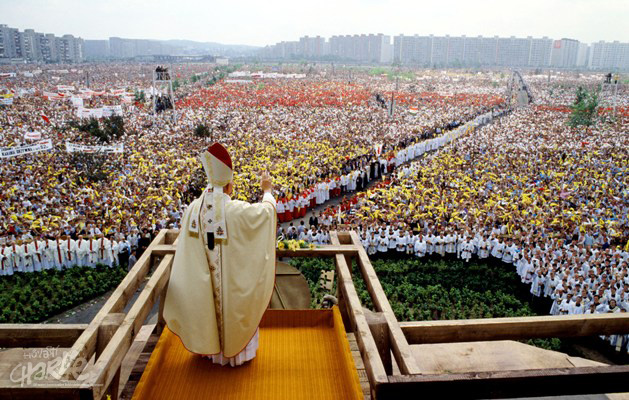
Led by Lech Walesa's dock-workers unions, Solidarity, Polish workers give serious affront to the Communist system in Poland
Electrician Lech Walesa
organizing Solidarity as the voice of shipyard workers at the Lenin Shipyards in
Gdansk, Poland - 1979
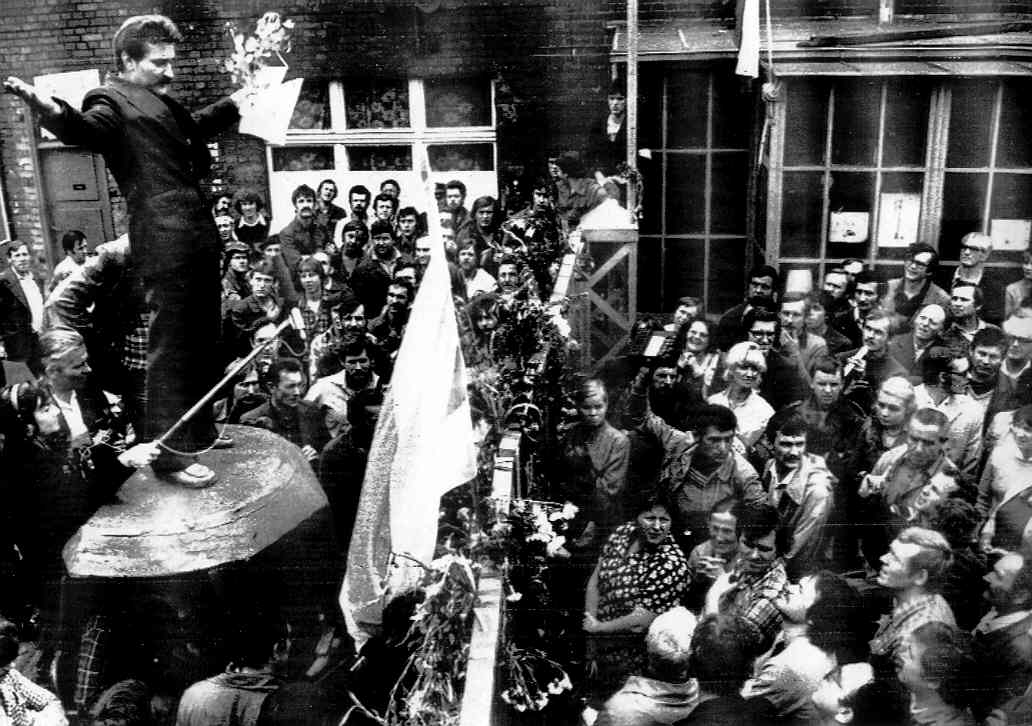
Lech Walesa leading the strike of workers at the Lenin Shipyards - August 30, 1980
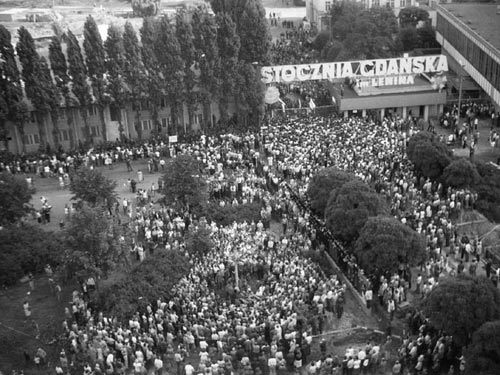
Striking workers at the Lenin
Shipyard - 1980
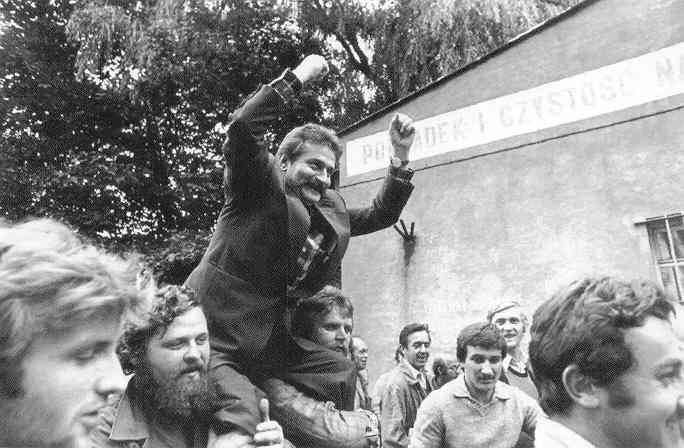
Lech Walesa - leader of the
Polish Solidarity labor union/movement - December 1980
Solidarity leader Lech Walesa
addressing striking Polish workers in 1980.
And the retreat of the Soviets out of Afghanistan in 1987-1988 only deepened the spirit of resistance in Eastern Europe
Soviet Commander Boris Gromov
announcing the Soviet troop pullout from Afghanistan - July
1987
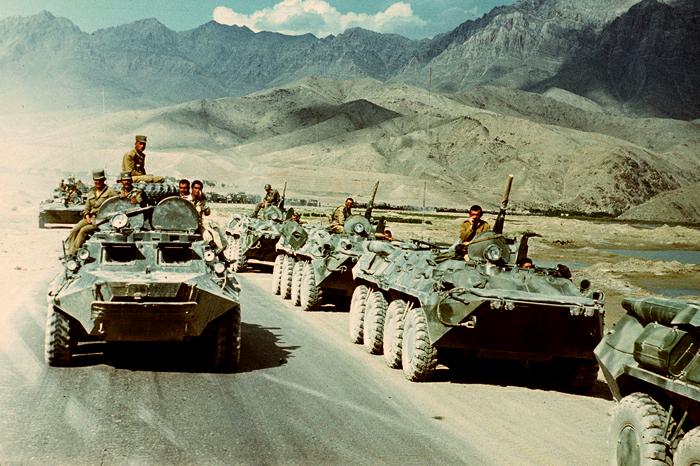 Afghan troops (on the left)
watching Soviet troops leaving Afghanistan - 1988
Afghan troops (on the left)
watching Soviet troops leaving Afghanistan - 1988Poland makes the first move
Polish Round Table Talks took place in Warsaw, Poland from February 6 to April 4, 1989 beginning the challenge of the East European "Soviet satellite" countries to Communist domination
The Germans, later that year, will make the long-desired move to "bring down that wall"
Celebrating the collapse
of East German Communism atop the Berlin Wall - November 10, 1989
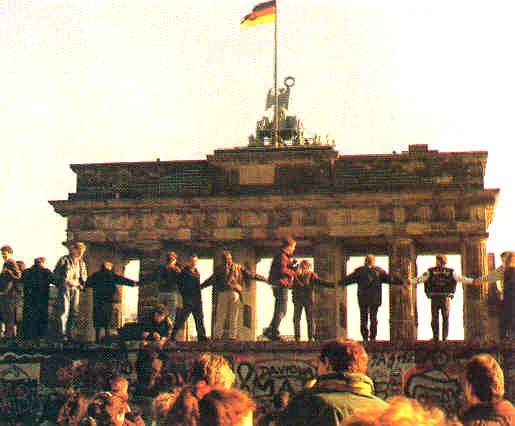
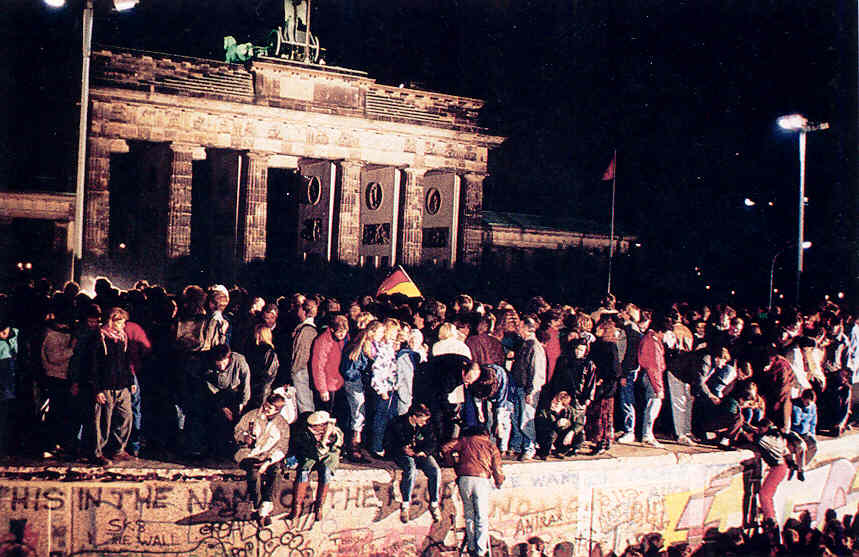
East and West Berliners celebrating
the end of 28 years of separation by the Berlin Wall -
November 10, 1989
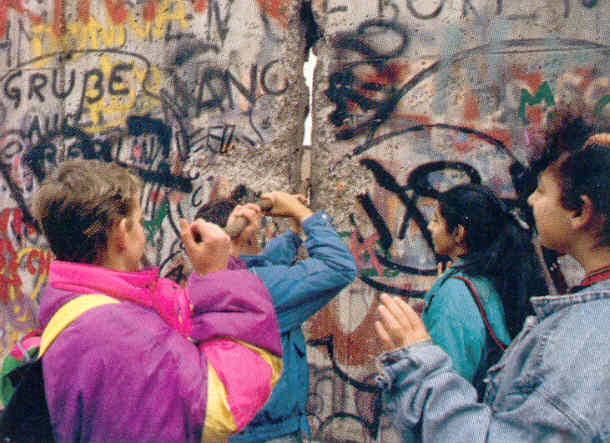
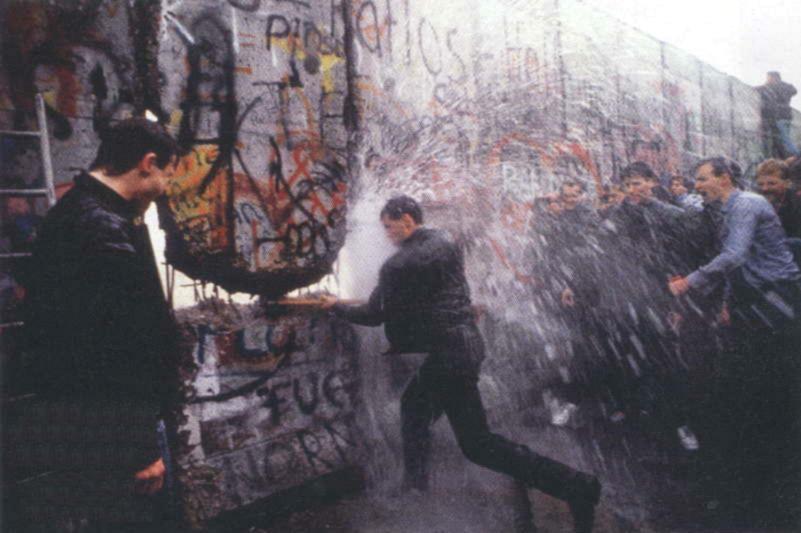
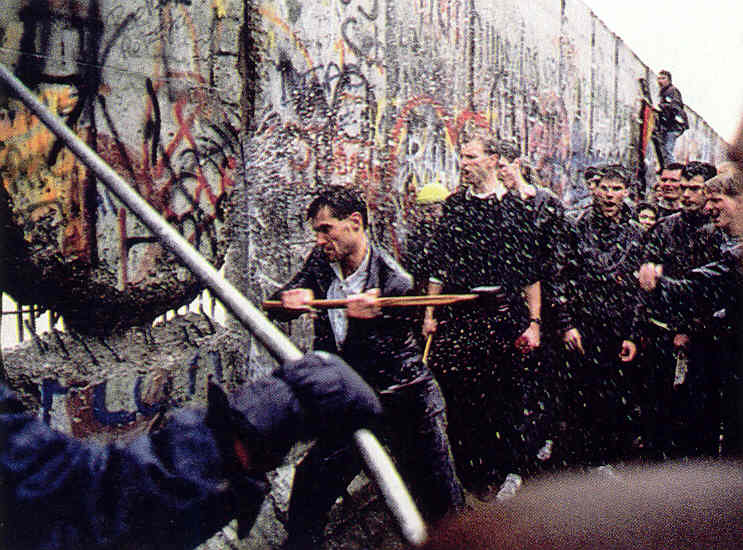
At the same time, the Czechs rise up in protest against the long-despised Russian domination ... with their "Velvet Revolution"
Vaclav Havel & peaceful Prague protest - November 1989
Wenceslas Square during the
Velvet Revolution - November 1989
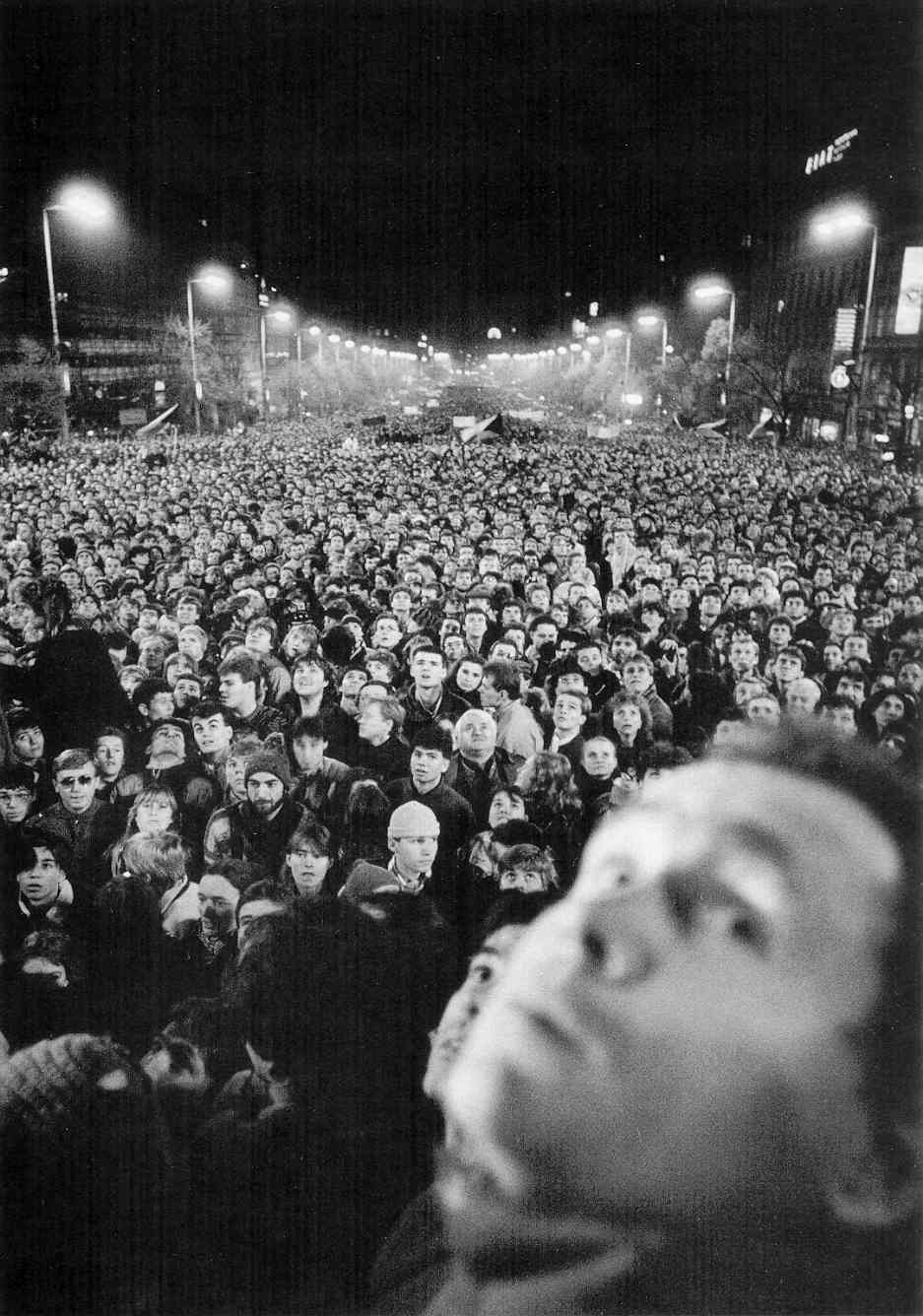
A pro-reform rally in Wencelas
Square in Prague - November 1989.
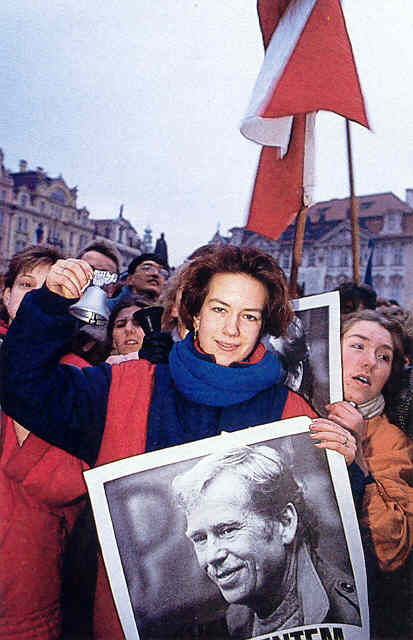
Czechs in Prague celebrating
their new freedoms
... won under the leadership of Vaclav
Havel
January 1990
However, similar developments in Romania do not go so peacefully
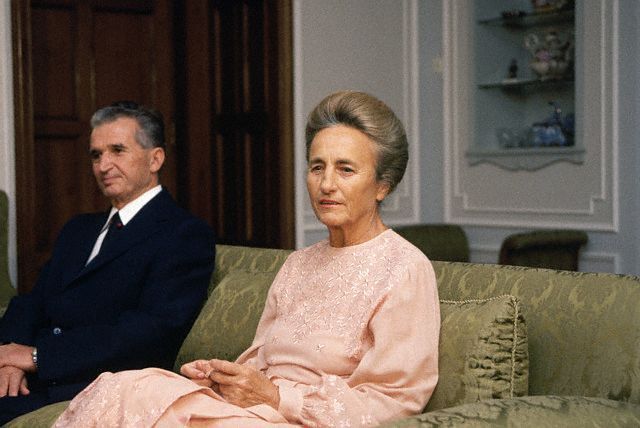
Romanian dictator Nicolae Ceausescu and his wife Elena (he had appointed his wife as Deputy Prime Minister)
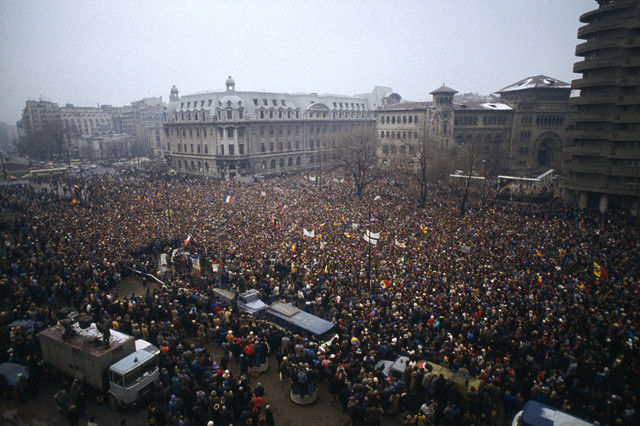
Romanian protesters in Bucharest - December 1989
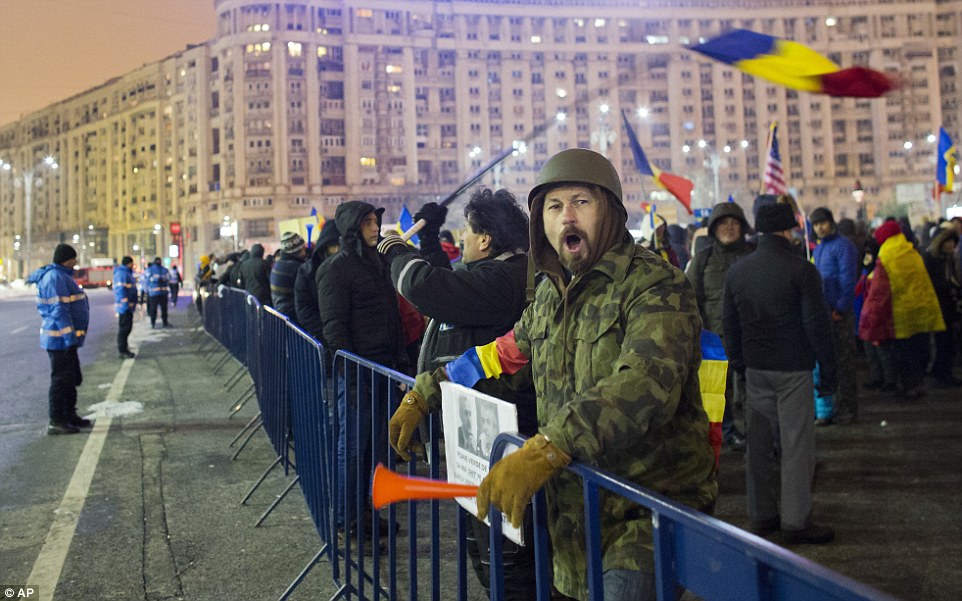
On December 22, the Romanian army would join the side of the protesters
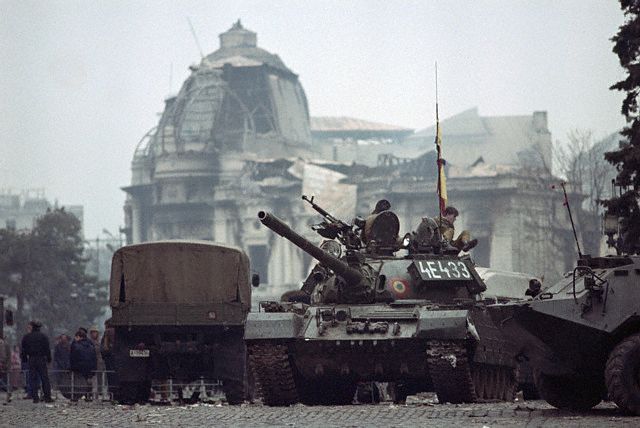
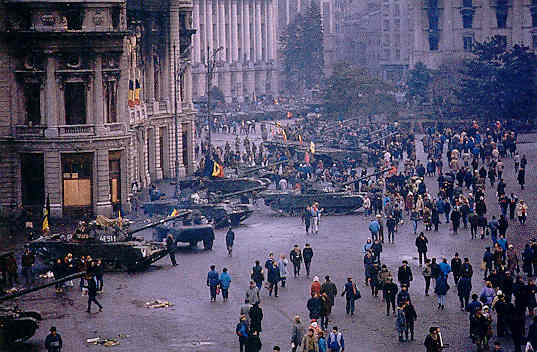
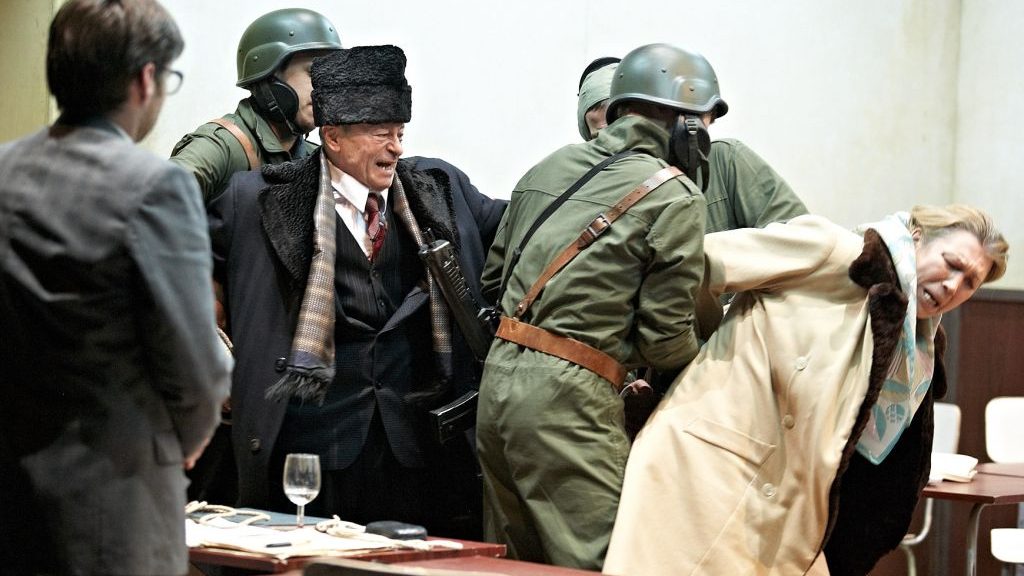
Nicolae Ceausescu and his wife Elena arrested on December 22,1989
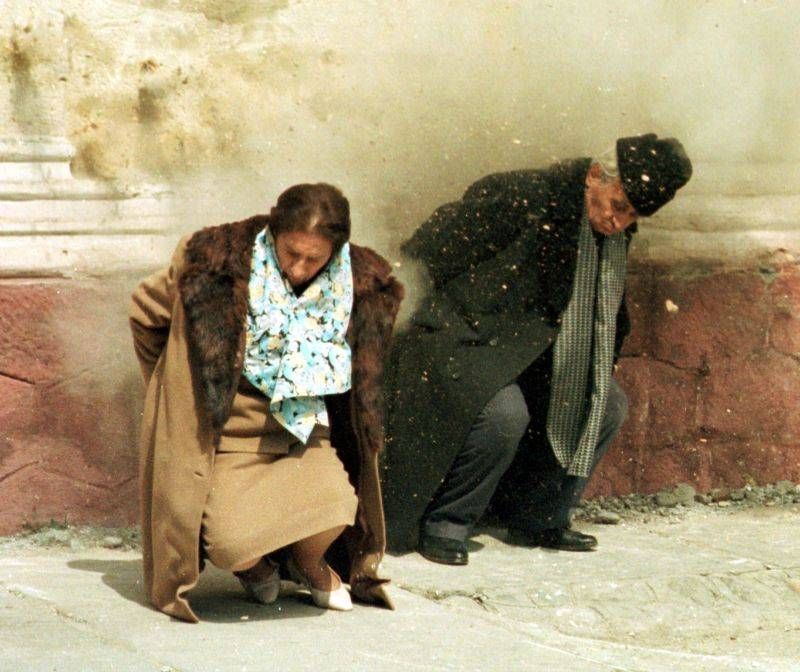 Romanian dictator Nicolae Ceausescu
and his wife Elena shot after a brief 60-minute trial
on Christmas Day. Merry Christmas Romania!
Romanian dictator Nicolae Ceausescu
and his wife Elena shot after a brief 60-minute trial
on Christmas Day. Merry Christmas Romania!
THE DISSOLUTION OF THE SOVIET UNION ITSELF |
| Perhaps
most unsurprisingly, the sight of various national groups in the East
European Soviet Bloc being able to secure national independence from
Moscow came quickly to have the same effect on the non-Russian minority
republics making up the Soviet Union. The first of these to go were the recently absorbed (a result of World War Two) Baltic republics, Estonia, Latvia, and Lithuania … part of a "Singing Revolution" in which patriotic songs stirred a rising sense of nationalism – in step with the easing of Moscow's grip on things begun by Gorbachev. Finally, on 16 November 1988, Estonia declared itself to be a "sovereign nation" … though still within the Soviet Union. Then, in follow-up to the departure from the Soviet Empire of the East Europeans in late 1989, Lithuania broke fully from the Soviet Union with its declaration of full independence on 11 March 1990. Estonia, Latvia and Georgia would follow Lithuania down the fully-independent path two months later. Soon other republics, importantly Ukraine, were at that point also deliberating full independence from Moscow. Then even Russia itself, under the leadership of Moscow's Mayor Boris Yeltsin, began to consider breaking from a failing Soviet Union and setting itself up simply as a member of a new Russian Federation. Clearly, the Communist Party was losing control of the political situation in what, at this point, was a dissolving Soviet Union. The newly created Soviet Parliament – in particular its Congress of People's Deputies – had not (as Gorbachev had hoped) brought new loyalties to the Soviet Union on the part of its various national groupings. The relaxed hand of the Kremlin had produced in fact quite the opposite. Finally, Gorbachev's refusal to block these moves towards national sovereignty1 so infuriated Soviet hardliners2 that in mid-August of 1991 they attempted by way of a military coup to seize control … and remove Gorbachev from power. They thus sent agents to arrest Gorbachev at his vacation estate (his daca) on 18 August … but simply ended up detaining him there. This then led Yeltsin immediately to turn the event into an opportunity to take Russia to full independence. Huge crowds of outraged Russians gathered in Moscow, with Yeltsin addressing them as their new Russian leader … with the leaders of the attempted coup at that point self-secluded inside the Russian Parliament Building. A three-day standoff then resulted, with the coup leaders finally surrendering ... or being arrested in their attempt to flee Russia (22 August). On the same day, Gorbachev returned to Moscow. Then the purge of hardliners would begin. Two days later Gorbachev resigned as head of the Communist Party … and the Communist Party itself was suspended in its operations five days after that (29 August). Then in early November Yeltsin simply outlawed the Party in his newly independent Russia. Thus for all practical purposes, the existence of the Soviet Union at this point was a mere fiction, with all the republics having declared their independence. In fact, in early December (1991) Yeltsin's Russia – now calling itself simply the Russian Federation – signed a treaty (the Belovezha Accords) with newly independent Ukraine and Belarus, declaring officially the end of the Soviet Union … and creating a new Commonwealth of Independent States (the CIS) – offering each other mutual economic, political, and military support. Most of the other former Soviet republics would join (though over the years many would depart). Furthermore, on 24 December, the Soviet seat on the UN's Security Council was transferred to Yeltsin's new Russian Federation. Thus officially and internationally, the Soviet Union was no more. 1In fact, he stood behind a New Union Treaty which was about to be signed – which decentralized much of the Kremlin's authority by extending new powers to the Soviet Union's constituent republics. In a referendum held on March 1991 - with Estonia, Latvia, Lithuania, Armenia, Georgia and Moldova not participating however – some 78% of the remaining Soviet citizens voted in favor of the treaty … renaming the USSR as a Union of Soviet "Sovereign" (not "Socialist") Republics. The republics Russia, Kazakhstan and Uzbekistan were about to sign this treaty when the coup occurred. 2Directors of the State Committee on the State of Emergency (the GKChP) formed in January of 1991. Actually, plans for just such a coup were first undertaken by the KGB as early as September of 1990. But they had to proceed cautiously … until events in August of 1991 finally forced their hand. 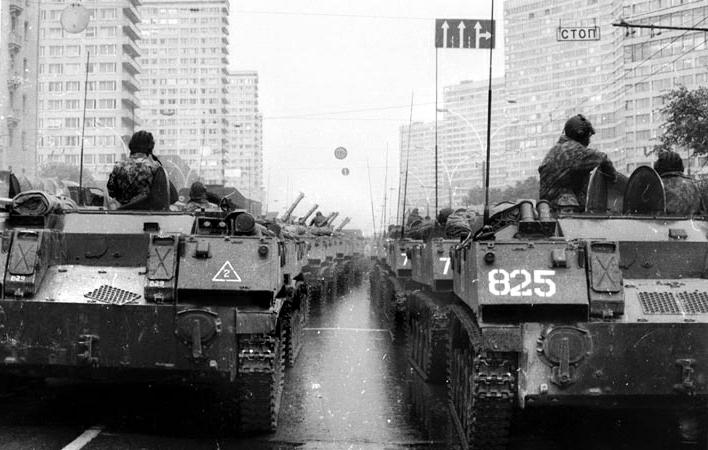
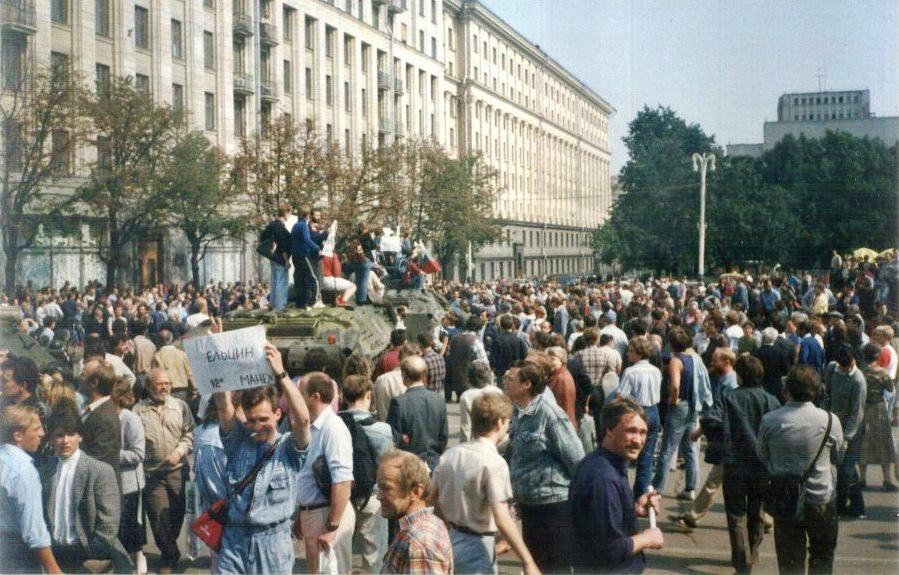 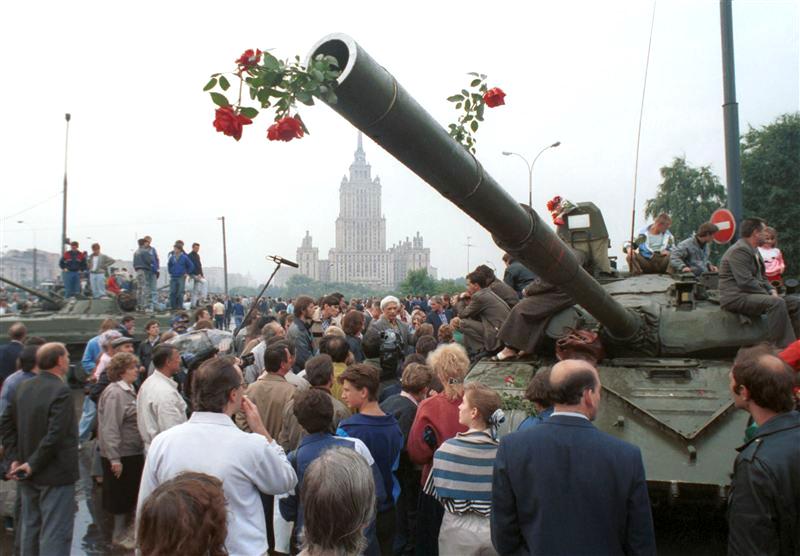
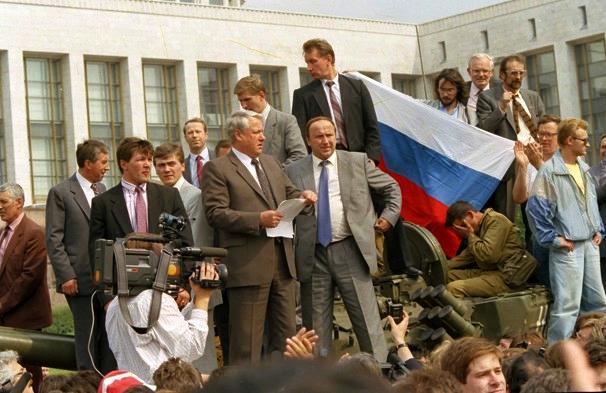
Boris Yeltsin on a tank addressing fellow Moscovites 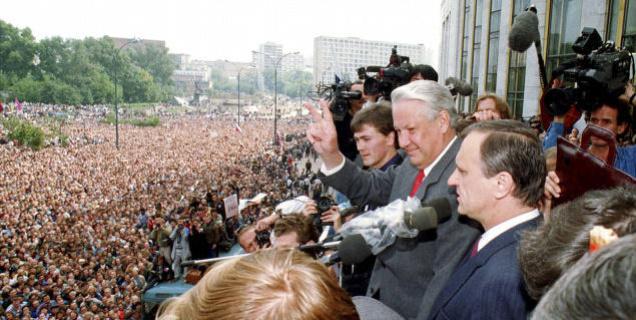
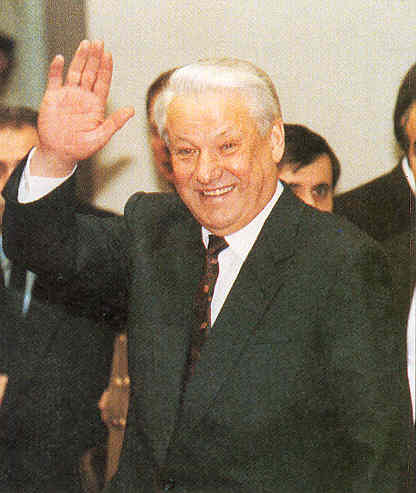
of some kind of Russian spiritual revival 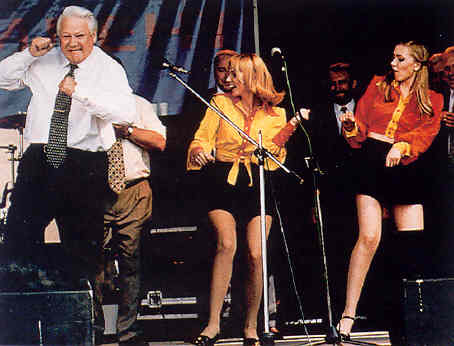
But the reality was that only a very small group of Russians were benefiting
from the "New Russia" ... while the situation deteriorated deeply
economically and socially for the rest of Russian society 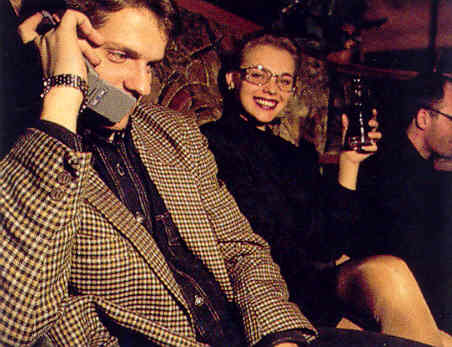 Russian Yuppies -
1994
Russian Yuppies -
1994
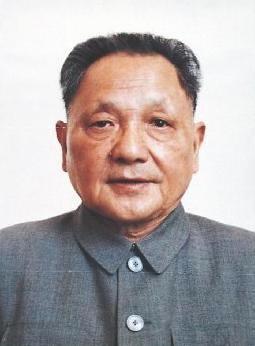 Deng Xiaoping not only succeeded in bringing down the last of the Maoists
(the "Gang of Four" led by Mao's widow, Jiang Qing) but opened up
Chinese society to the world on a new international trade basis
... taking for himself only a small visible role.
And the Chinese economy exploded in amazing growth
(10% annual growth during most of the 1980s and 1990s)! Deng Xiaoping not only succeeded in bringing down the last of the Maoists
(the "Gang of Four" led by Mao's widow, Jiang Qing) but opened up
Chinese society to the world on a new international trade basis
... taking for himself only a small visible role.
And the Chinese economy exploded in amazing growth
(10% annual growth during most of the 1980s and 1990s)!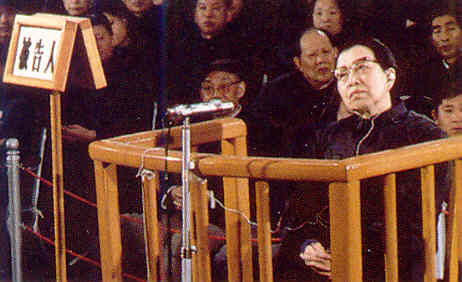
But a serious problem began to develop in the late spring of 1989 -- as Chinese students began to demand some of the same political-social reforms that they saw Communism undergoing in Eastern Europe Students in Tiananmen square calling for reforms in China similar to those undertaken in Russiaby Gorbachev - Spring of 1989 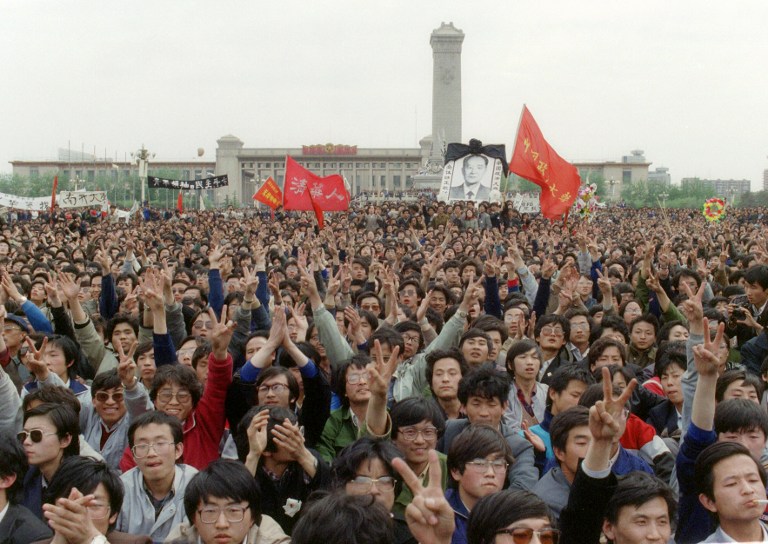
April 22, 1989 -
thousands (200,000?) of students at Tiananmen Square gather to honor 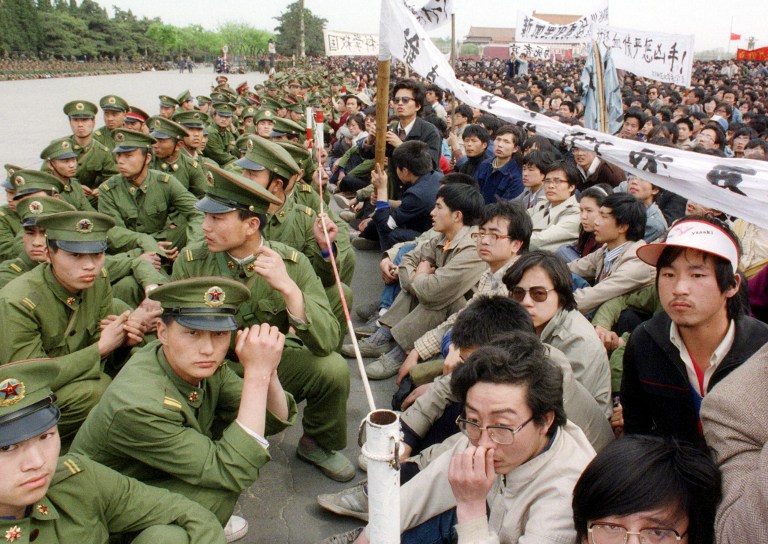
Police and protesters meet at a line drawn up in front of the Great Hall of the People Student demonstraters gather in ever greater numbers in Tiananmen Square, Beijing - April 27, 1989 Students in Tiananmen Square
in silent protest before the Red Army - late spring 1989. 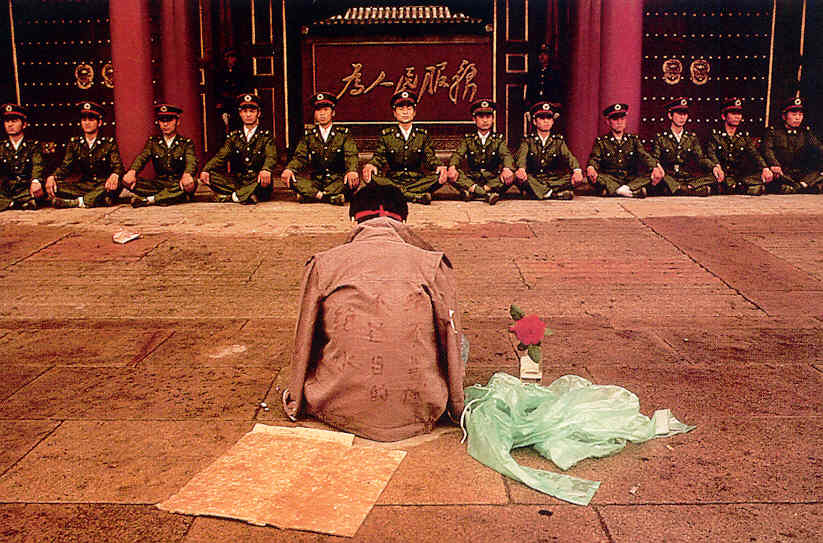
A student protester seated before the Chinese military - May 1989. 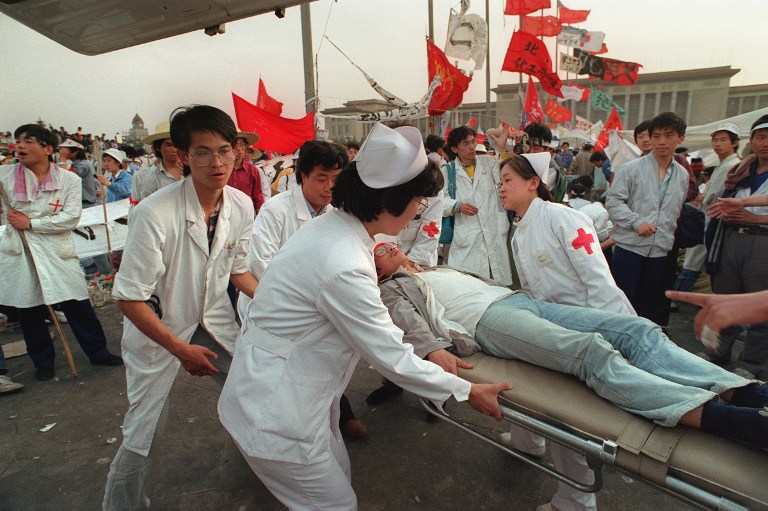
In mid-May a number of the students undertook a hunger-strike to protest in favor of democracy By the beginning of June hundreds of thousands (a million?) had convened on Tiananmen Square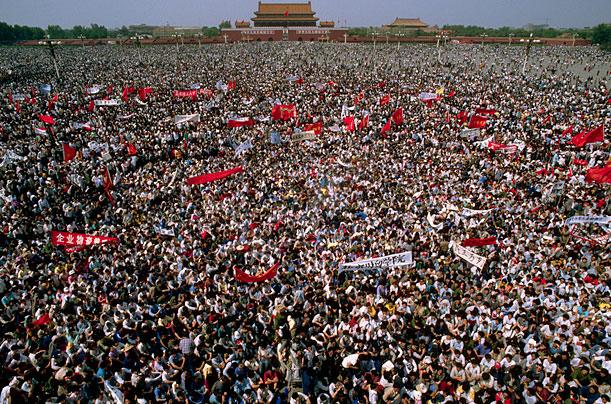 On June 4th, masses of troops are brought in to clear the Square of the protesters 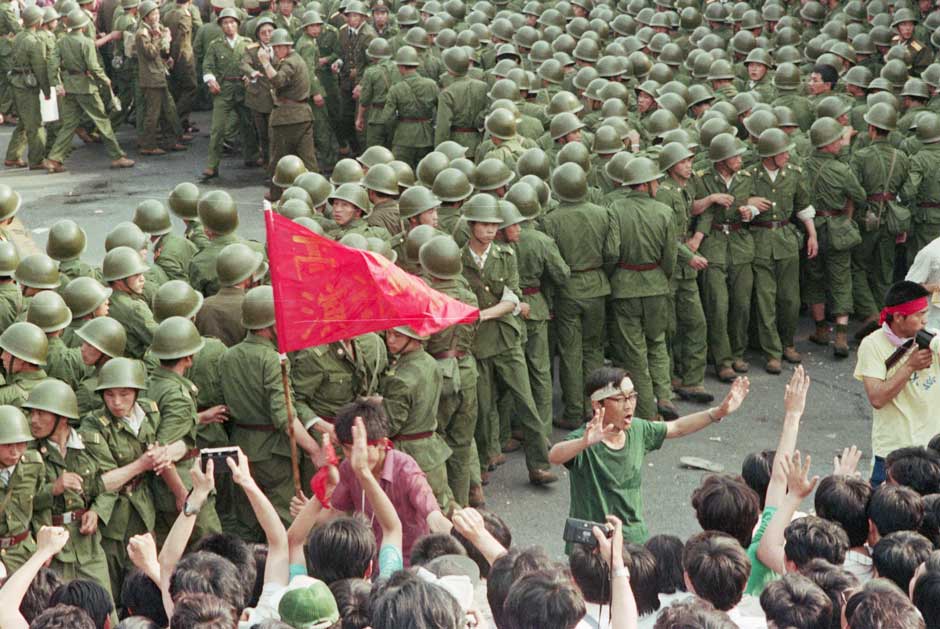 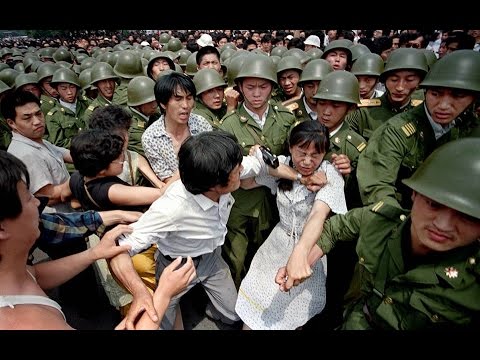 The clearing of the Tiananmen Square by soldiers turns violent 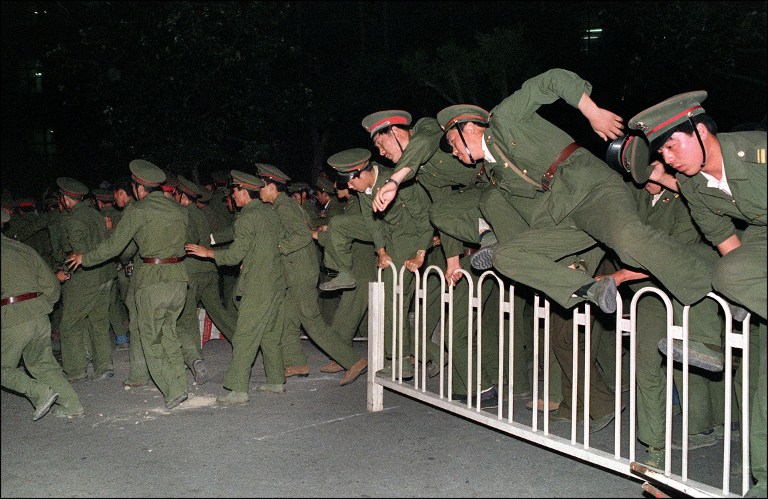 On the night of June 3-4 the soldiers begin their move to clear the Square of protesters 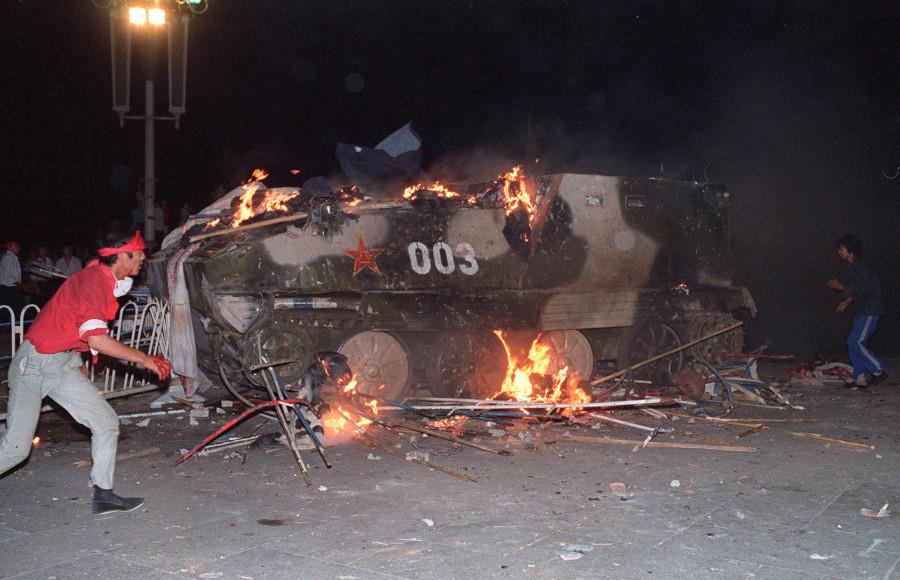 
The aftermath of the Tiananmen Square
protest 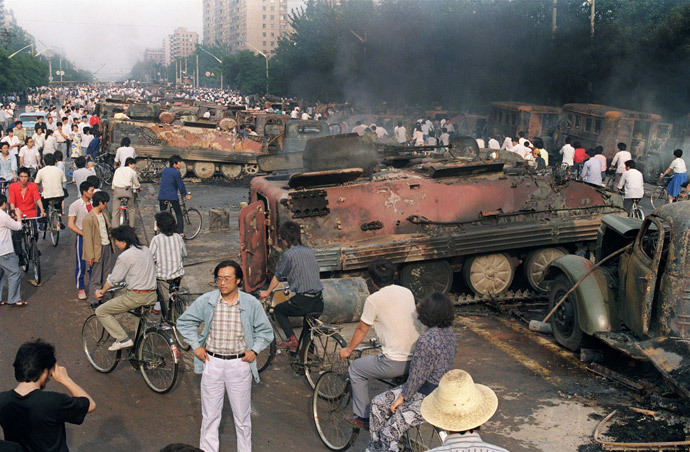 Burned out personnel-carriers On June 5, a multitude of tanks show up to prevent the protesters from returning to the Square 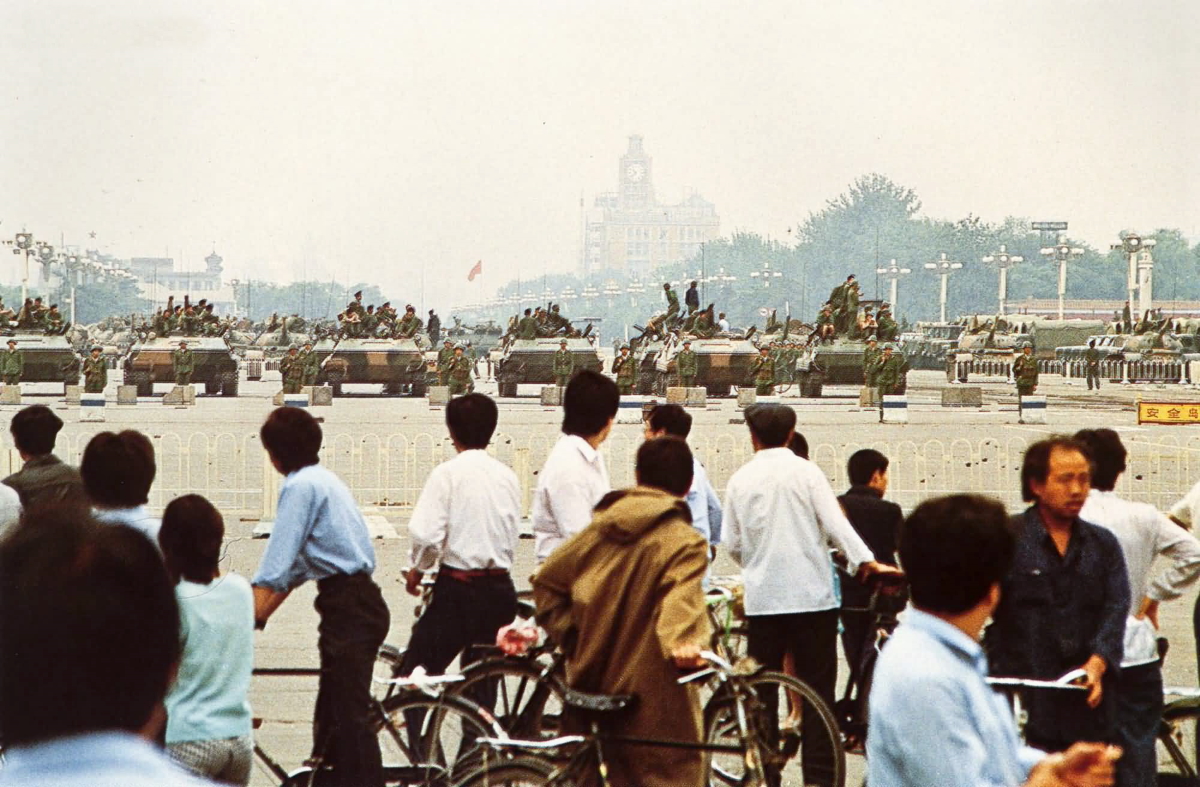 Tanks advancing on the remaining protesters A student defying Chinese
T-59 tanks in Tiananmen Square - June 5, 1989 A lone protester and Chinese T-59 tanks at Tiananmen Square - 1989 American President Bush was very upset over the Chinese handling of this protest ...
but actually could do nothing about the matter. Soon the West lost sight of the event
... as did also the Chinese themselves
 Go on to the next section: Europe Moves Ahead
 |



